Audi RS Q8 Performance 2025: Australian first drive
Audi Sport’s most-powerful combustion production vehicle ever is a family affair. And despite the bonkers prowess, it’s a fine SUV all-rounder in its own right
Let’s not bury the lede: the single most impressive and surprising aspect of the newly facelifted Audi RS Q8 Performance is not its lengthy list of go-fast credentials, but that it’s such a pleasant thing to drive and live with (with one caveat) despite its excesses.
Put simply, being a fine daily driver is the only thing Audi’s most-bonkers combustion model needs to accomplish. Because everything else about it, particularly this most potent Performance variant debuting current-gen RS Q8’s midlife update, is an indulgent want.
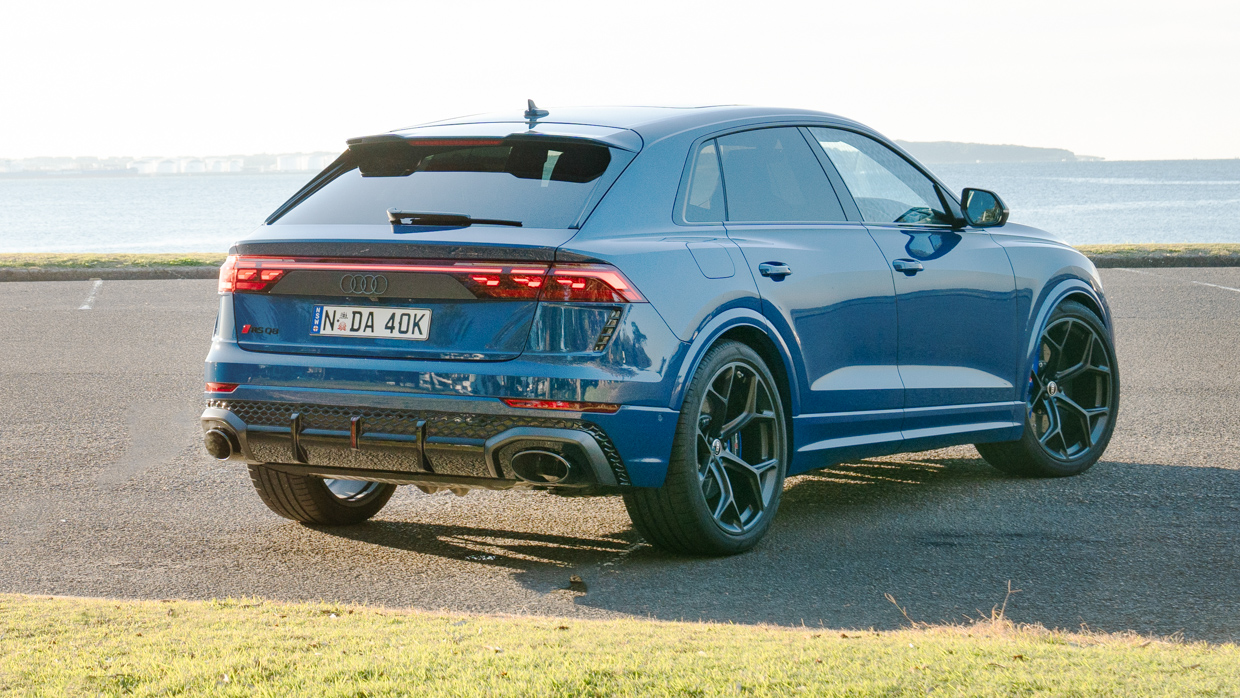
And because, for fair or foul, Audi Sport Gmbh decided that the most powerful combustion vehicle it’s yet unleashed on the road, bringing with all sorts of high-performance promise, is a large luxury-infused family-hauling SUV.
This is no new concept for the Ingolstadt concern – as we pointed out four years when RS Q8 launched, Audi Sport once pedalled a 1000Nm diesel V12-powered Q7 in the height of the skunkwork’s radical oiler Le Mans racing campaign. But with this latest take, it seems Audi’s ‘bonkers SUV’ concept keeps getting smarter, quicker, more excessive and even less sensical.
So, credentials wise, where does Audi (Sport) stake its ICE claim in 2025? It starts by drowning out the deathknell for internal combustion’s demise with a howling and familiar 4.0-litre biturbo V8 – no electric augmentation required – to a tune of 471kW – yes, 630-plus horsepower – and 850Nm.
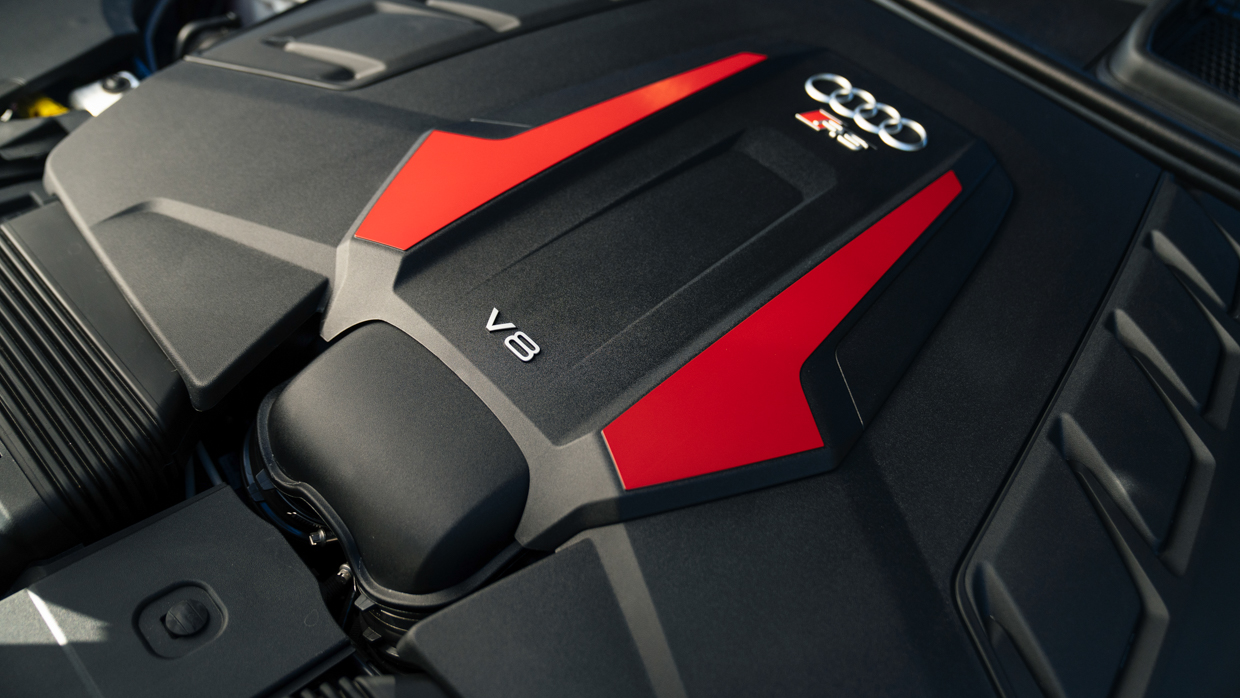
Of course, that’s a magnitude more than one needs for school runs or taking Fido for walkies down the park. But if you want to hit 0-100km/h in 3.6 seconds or lap the Nurburgring Nordschleife in 7min 36sec-ish – two-tenths and six seconds quicker, respectively, than old RS Q8 benchmarks – then this facelift has you covered, says Audi.
The price of admission is also heady: $255,800 before on-roads, options and a very healthy budget allowance for fuel and tyres. But a fair chunk of that investment also goes into a very long list of technical support systems aimed at massaging a semblance of family-friendly Hyde out of what’s potentially one very unhinged Jekyll.
Like brakes. At 440mm, the ten-piston front anchor’s ceramic discs are, says Audi, the world’s largest for a production car, here wisely as standard (when they were once a $20K option) for a rig weighing 2350kg. Sheer disc girth necessitates whopping 23-inch wheels, forged and five kilos per rim lighter than the old models’ 22s.

There’s a lot more. Adaptive air suspension ‘Sport’ tackles the formidable bump and rebound duties, while a familiar chestnut in the 48-volt electromechanical roll stabilisation system contends with the RS Q8’s considerable cornering inertia in the heat of the mid-corner moment.
Post eight-speed auto, quattro drive is split 40 percent front and 60 rear, the latter via a tricky rear axle differential. Further enhancing the RS Q8’s cornering chop is all-wheel steering, reducing the turning circle by a full metre at low speed with countersteer, while acting complimentary beyond 80km/h for high-speed stability.
Plenty of party tricks, then, though not much is new. Added biturbo stonk demanded lots of calibration polishing, though outside of a broader mild-to-wild stagger in the drive mode selection, innovation is slim. Again, there’s not even the mildest hybridisation or electric drive assistance here in this red meat-chomping behemoth.

The facelift updates are predictable: a new singleframe front fascia, revised rear bar, and some digital front DLRs and an OLED rear array from a brand renowned for lighting trickery. New rim designs (in a choice of three finishes) and paint choices – Shakir Gold, Ascari Blue, Chilli Red – complete the exterior midlife makeover.
Inside, there’s a choice of five revised Design Package Plus ‘themes’, mostly a choice of highlight colour for the lushy diamond stitched Valcona leather seats. Some trim decor is revised and the Performance version of RS Q8 gets bespoke Virtual Cockpit content.
Otherwise it’s carryover stuff, slightly old-school compared with some of Audi’s newer E-Tron offerings if not a fault, the cabin exuding richness and familiarity. Materials are varied and nicely sombre – the console, dash and door touch points are all beautifully stitched nappa leather – though the RS Q8 neatly sidesteps the gaudiness flaunted inside some big-buck luxo SUVs.

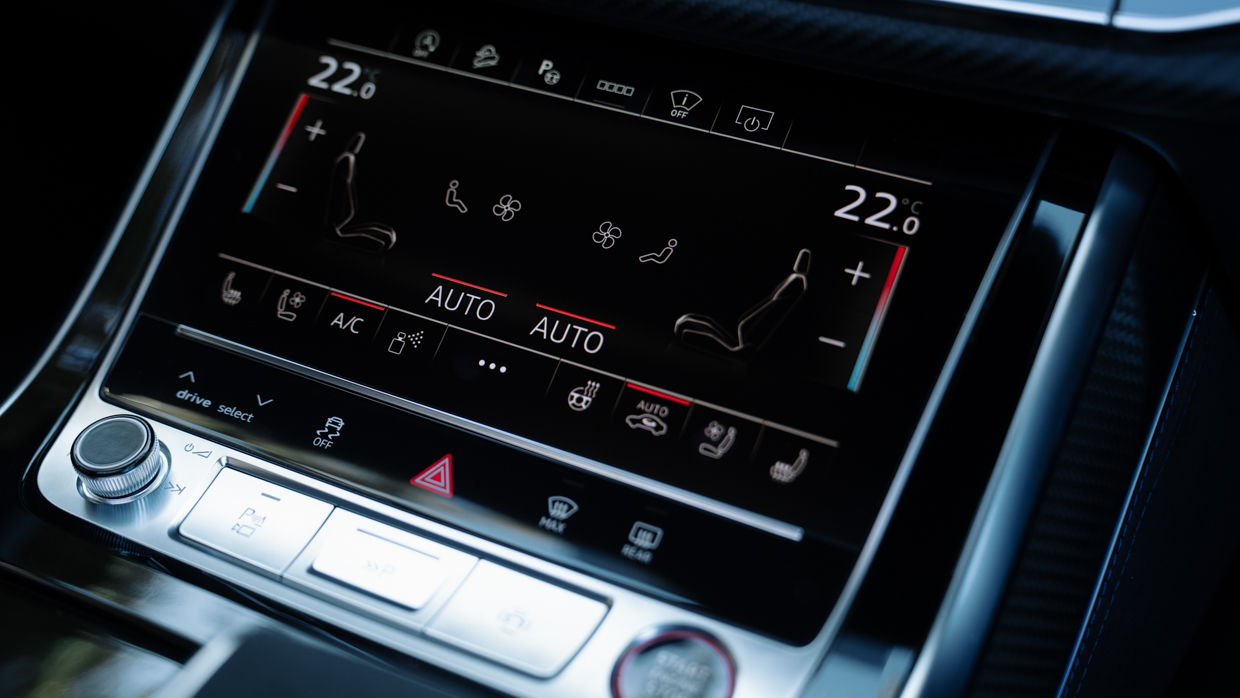
It’s as amply roomy and airy as you rightly expect in such a large rig, though the seating and ergonomics still bring a strong whiff of oh-so-RennSport sportiness and purpose. The seats are as supportive as they are seemingly infinitely adjustable, with ample bolstering for the heat of the battle yet leisurely enough for genuine long-haul comfort.
It’s feature laden. The dual stacked 10.1-inch media and 8.6-inch ‘control’ screens remain, with acoustic and haptic feedback, though the MMI media format looks five years old in this era of fast-moving in-cabin tech.
The dignified luxury effect continues through to row two, where accommodation is roomy if not cavernous, as comfy as a well worn Chesterfield lounge and decked out with an expected array of multi-zone climate adjustment and device power. It’s a nice place to be for long family road trips. Boot space is decent 605 litres.
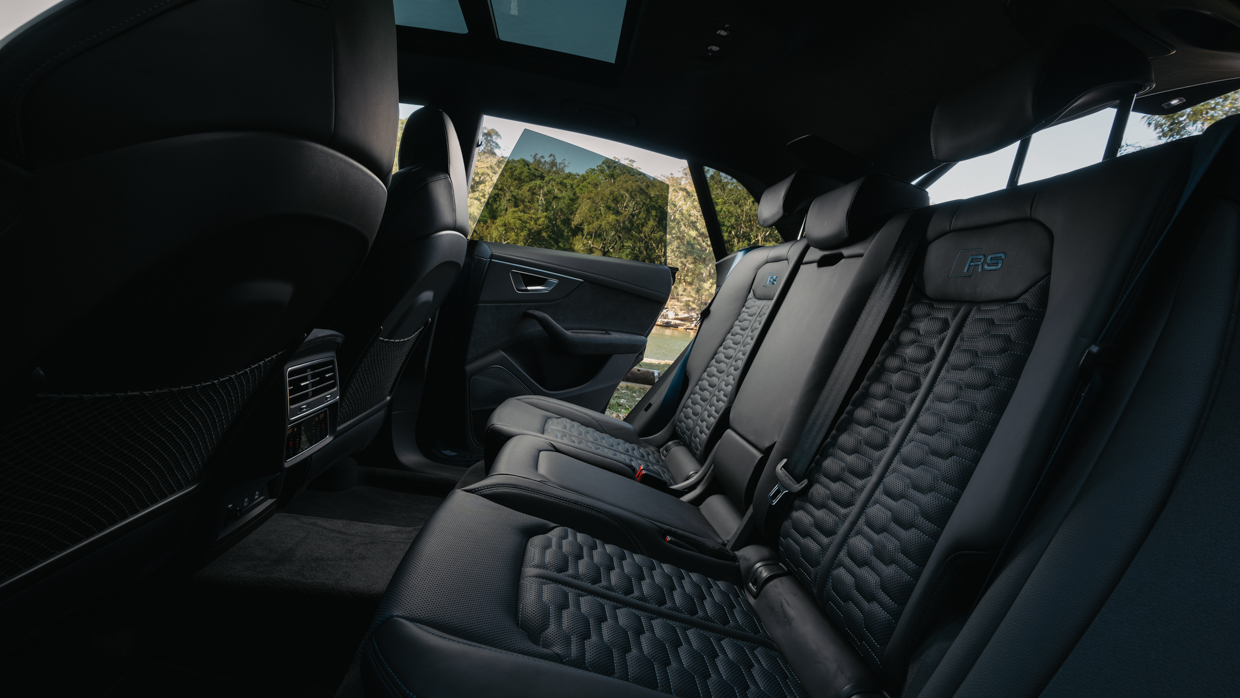
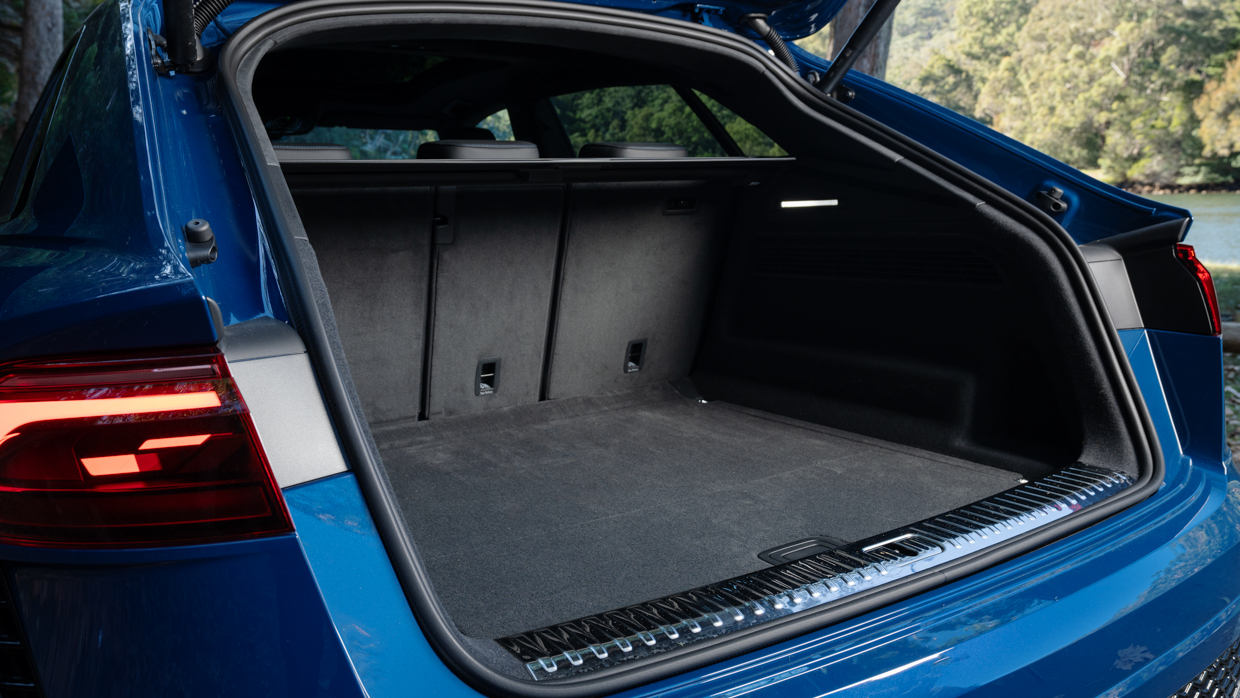
Our tester demands an added $2300 for ‘Matt Carbon twill’ inlays and your half-mil cleanskin version can rocket towards $300K quickly with options.
An RS Design Plus pack ($4100) is a bit of an Alcantara/Dinamica/stitching fluff up, the Sensory pack ($9700) swaps Bang & Olufsen’s 17-speaker 730-watt audio for more elaborate 23-speaker 1920w excess plus other tweaks, while there’s also a expanded Matt Carbon ($9800) exterior spruce up with results of questionable taste. To each their own.
The local launch of the RS Q8 in Queensland was punctuated by a stint at its famed Lakeside Park raceway, not for hot lapping but to demo the SUV bruiser’s acceleration chops on the main straight.
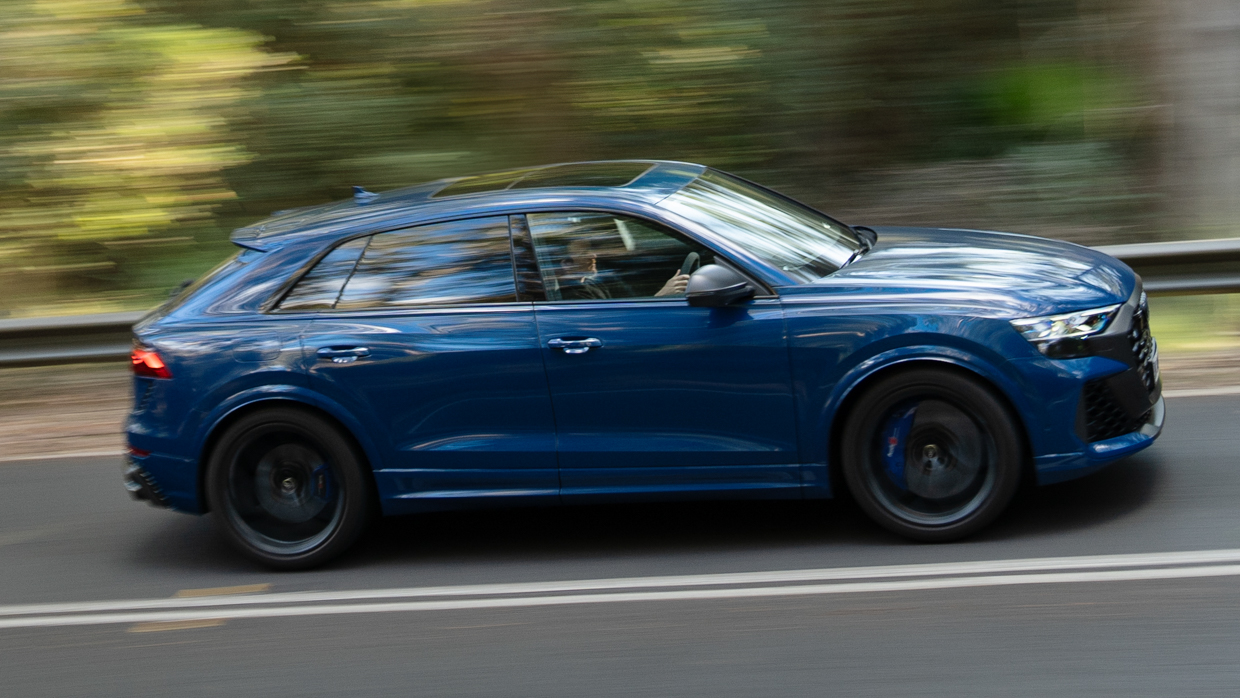
A stiff headwind and uphill run stifled a personal best, with a 3.9sec pass for the 0-100km/h sprint. But, jeez, the drama and theatre of that bent eight on full song, bellowing like an Olympic weightlifter and seeming defying physics, is very intoxicating.
But it’s really the aplomb of how the RS Q8 can tame its manner and contain itself on a leisurely cruise, its engine purring along like a Bengal tiger in an afternoon snooze, that is truly impressive.
Around town or on a motorway, it’s as polite and polished as any luxury SUV half its price, and I mean that as a genuine compliment. Bar the torquey undertow beneath the right foot – no peakiness, no histrionics – you very quickly forget you’re perched at the bring of ultra-performance that’s just a stomp of the right foot away.

In Comfort, it’s pliant and rounded enough in manner that you never feel like you’re reining its performance in or that tooling about in a commute demands any sort of driver restraint. The wheels patter across expansion joints a touch, but otherwise there’s little to suggest you’re in anything other than a luxo-tuned cruiser.
The ride from the air suspension is pliant and well judged, the steering is connected without feeling fizzy or urgent, and even the progression from those massive ceramic brakes feel utterly normal and pedestrian. It’s a placid beast when you want it to be.
Find some twisty backroads, in this case the Queensland hinterlands west of the Sunshine Coast, and the RS Q8 dials in an undertow of muscle and eases into the task of drumming pace. And there’s enough of it, paired with linear and instant response, to drum up a serious clip without having to reach for the drive mode selector.

It feels big, especially on tighter bits of hot-mix with no available run-off, but its various chassis systems do conspire together to reveal impressive dynamic talent. The RS Q8 is easy to hustle – if sometimes a tricky to judge, given its size – and it’ll point and shoot between apexes at a clip that nearly 2.4 tonnes of German metal really shouldn’t.
Having spent time in the old version in environments that allow for dynamic exploration, the RS Q8 can become reasonably playful once its broad 295mm-wide footprint cries freedom from the tarmac. And while I don’t doubt this face-lift is equally talented or better, the tight and lumpy Queensland mountain roads are not the place for proper exploration.
That hefty kerb weight makes for formidable lateral inertia that demands decent real estate to recover from. And while the RS Q8 does hang on like it’s on rails to a point, when the road gets slippery its heft, plus the abundance of energy this rig musters up, demands a measured approach at the helm.
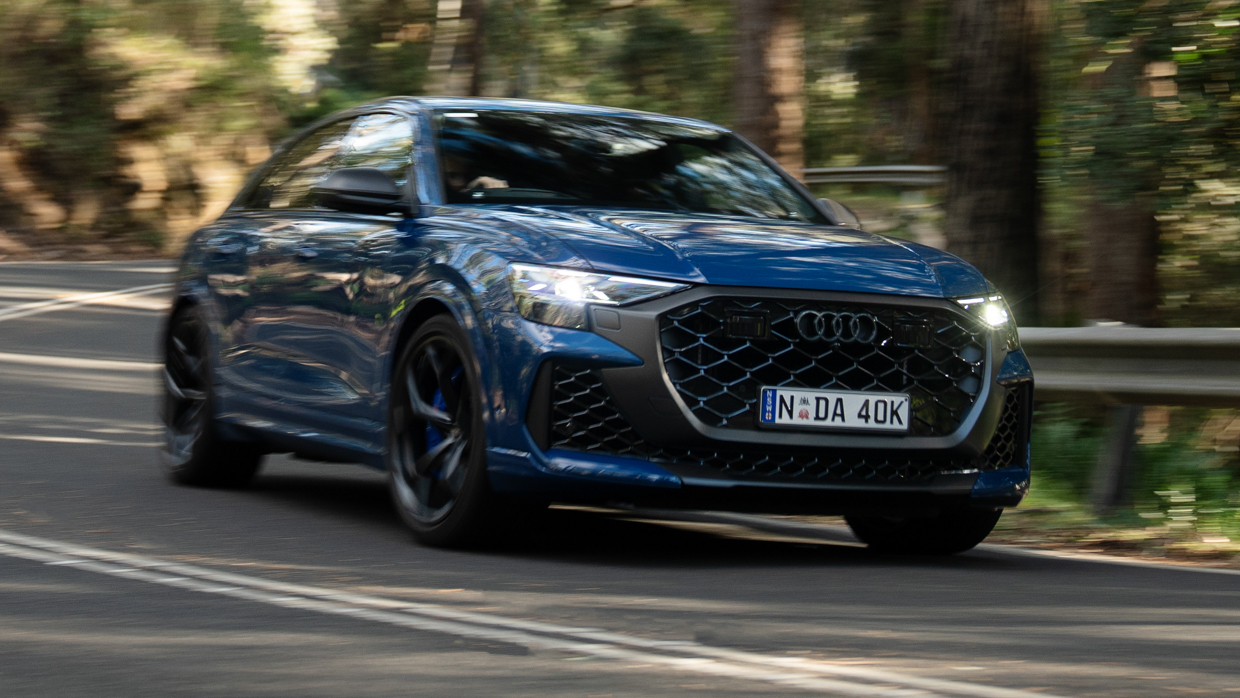
Ditto urgent changes of direction, perhaps the trickiest request one can make from a plus-sized high-performer. Again, what the RS Q8 is capable of (in good, dry conditions) is nigh on miraculous, but Audi Sport’s most potent combustion model to date is far from its friskiest, or a genuine leader in driver engagement and fun factor. That’s physics for you.
But as a do-almost-anything allrounder, the RS Q8 is a hard act to pick holes in. And opting for the pricer, go-fast Performance variant doesn’t seem to impinge on what is a wonderfully resolved balance of sportiness, performance and luxury that it’s clearly out to achieve.
The RS Q8 offers an abundance of fury and frills, if one without the shouty ostentation of a Lamborghini Urus or a Bentley Bentayga or in price – both corporate cousins starting from around $400K and head well north for the spicier variants.

Price notwithstanding, the cut of the RS Q8’s jib alone will make it much more desirable to those after premium family hauling where outlay is of little object. As it ought to be given the V8’s heady thirst – its 12.2L/100km combined consumption is optimistic as best.
Servicing, though, is $4690 for a five-year plan and quite reasonable given the performance potential on offer.
At the time of review, Audi had just announced a regular RS Q8 will join the go-faster Performance in 2025 facelift form, the slightly more attainable and pragmatic 441kW/800Nm combination matching pre-facelift prowess (3.8sec 0-100km/h) at roughly a ten percent discount ($230,900).
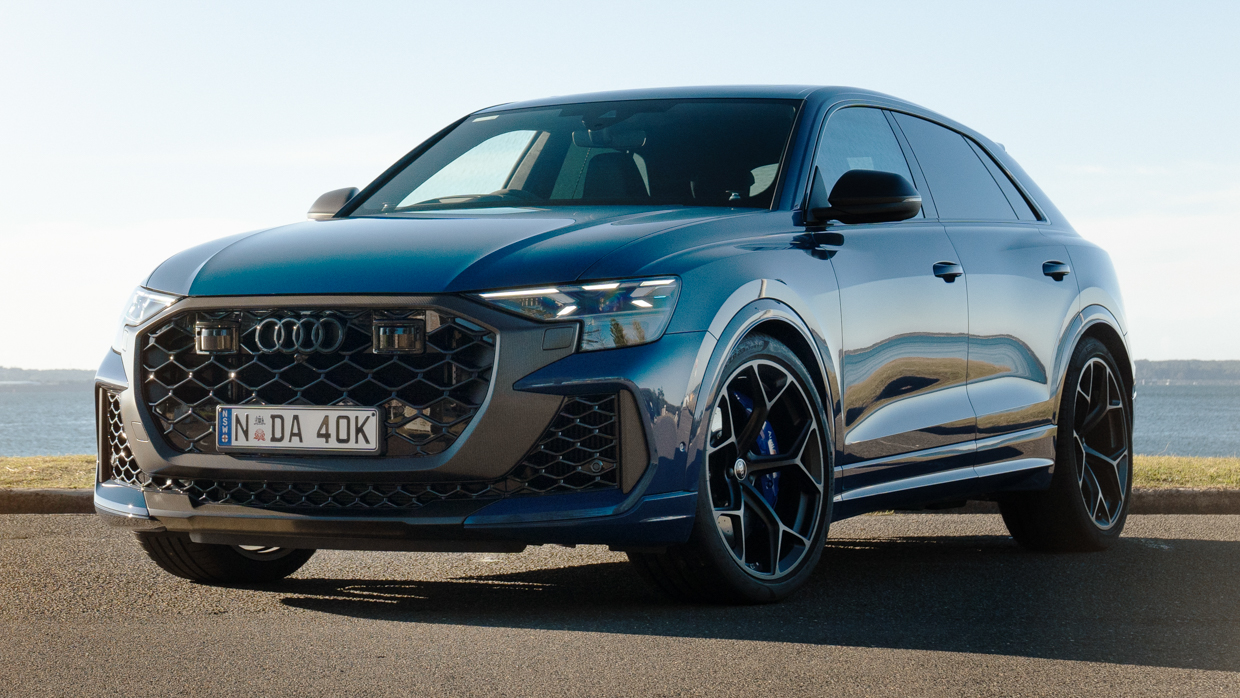
Fair enough. That’s still an astonishingly big stick to swing for a plus-sized family truckster.
But for what’s saving a few shekels in adjustment in the lease payment, you’re essentially opting out of the status of the most powerful combustion vehicle Audi has ever devised…
We imagine most buyers will stump for the tree-topper. In for a penny, in for a pound, they’ll likely say…
Subaru WRX tS Spec B 2025 review
3 months ago

It’s nicer, pricier and sportier, but does the WRX for devotees muster up any of that old-school STI magic?
Good points
- Punchy, cooperative powertrain
- Excellent variable ride
- Clear driver engagement
- Tasty Spec B features
- Old-school charm
- Priced nice enough
Needs work
- No bona-fide STI spirit…
- …or hardware to match
- Uncomfortable Recaros
- No Sportswagen option
- Old-school execution
- ‘STi-ling’ highly subjective
Kudos to Subaru for bucking modernisation pressures to persist with an old-school WRX recipe for gearhead buyers with traditional tastes and whims.
The “rally derived” mantra might not hold the dirty, oily water it once did, but the pitch remains, pumping a decades-old turbo-boxer lifeblood through “symmetrical all-wheel drive” convention.

However, the properly hot STI machines are no more, with Subaru sadly — if wisely — putting the hallowed nameplate on hiatus years ago when the rally-homolgated DNA that defined ‘true STIs’ dropped off the recipe as the Japanese carmaker’s formal rally ties subsided.
In 2025, we’re left with the WRX AWD tS Spec B as a missing link of sorts.
Framed as the nicer, sportier, most-STI-alike enthusiast special of the erstwhile MY24 line-up — there’s a caveat coming — it’s positioned as the closest thing to truly bottling good-old noughties all-paw rally-inspired fun factor…without the proper rally-bred STI credentials.
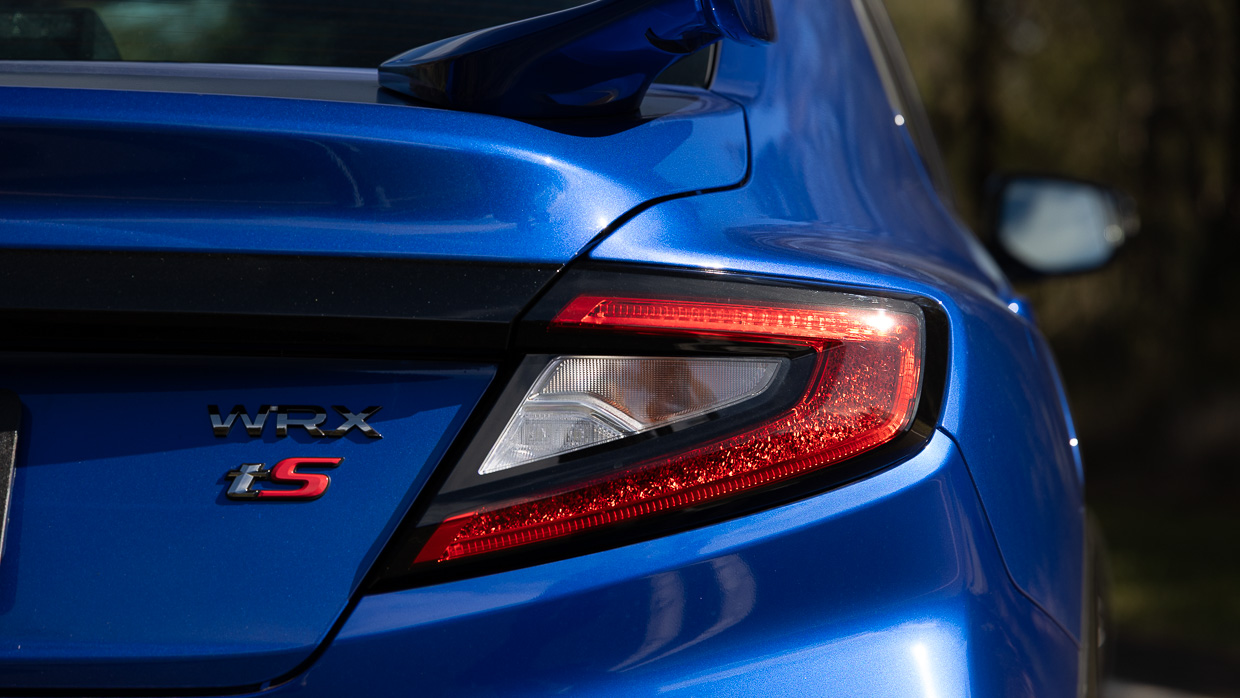
One that’s modernised just enough to slip through contemporary road-going emissions, safety and tech auspices. Is it any good? Is it anything like a classic STI experience? And is it worth its premium? Let’s find out…
What are the WRX tS Spec B’s features and options for the price?
Launched in March this year, the tS Spec B variant exclusively brought 19-inch wheels, high-performance Bridgestone rubber, big six-piston Brembo brakes, a circa-2005 rear wing, a 12.3-inch digital instrument cluster and rig-hugging Recaro front bucket seats to the now nine-variant-strong WRX line-up.
And at a palatable $61,490 before on-roads.
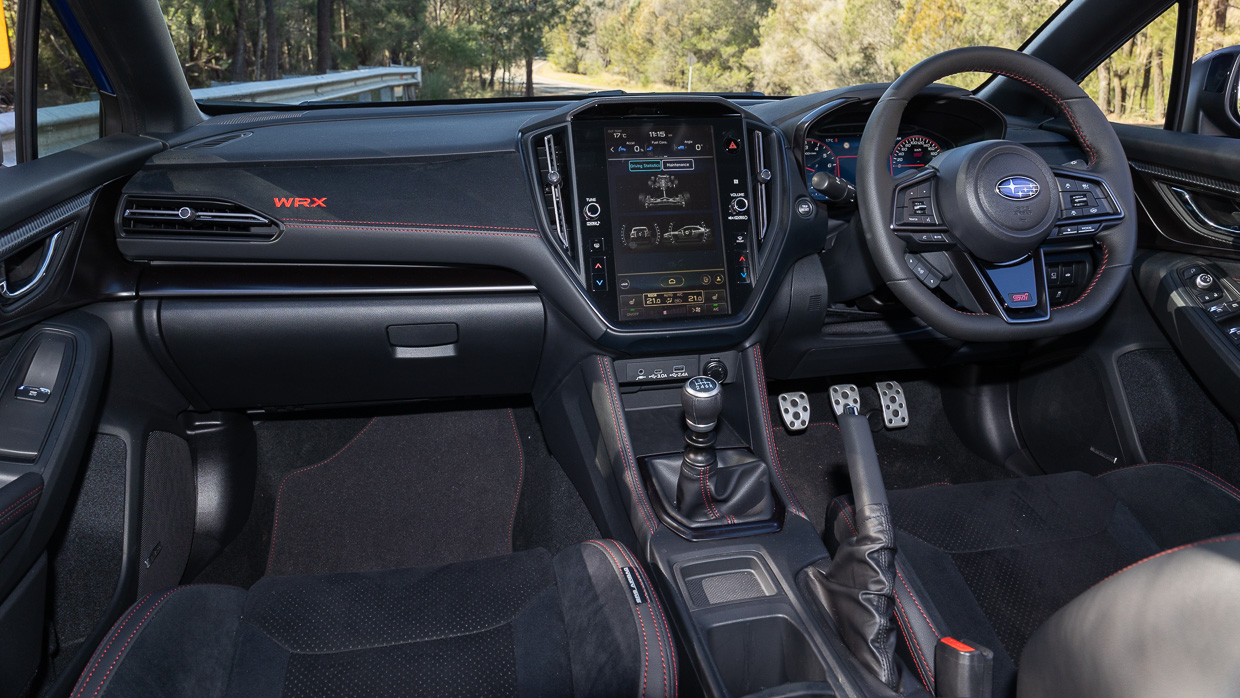
A month after the Spec B debut, Subaru announced an updated MY25 WRX line-up, that went on to add the once-exclusive Recaros and 12.3-inch driver’s screen to all three tS — short for ‘Tuned by STI’ — sedan and Sportswagen variants, robbing the Spec B of a couple of key unique selling points.
Crucially, the tS Spec B remains the only WRX version offering both a six-speed manual transmission and electronically adjustable suspension dampers paired with Drive Mode Select.
The bad news? At 202kW and 350Nm, it’s the same 2.4-litre boxer used elsewhere in the WRX line-up, so no higher outputs.

And, sadly, there’s no ‘Sportswagen Spec B’ as yet — all five-doors maintain the Lineartronic CVT auto, a powertrain that also misses out on the manual sedan’s viscous centre LSD.
All of this leaves the Spec B variant no quicker than the regular — and $13,300 more affordable — manual WRX sedan and with precious little in the way of inimitable specification outside of rolling stock, questionable boot appendage and adaptive dampers.
WRX tS Spec B features include:
- 202kW and 350Nm 2.4-litre turbocharged boxer four
- Six-speed manual with viscous centre LSD
- Electronic control damper system
- Active torque vectoring
- Drive Mode Select (five modes)
- Six-piston/two-piston Brembo brakes w/ ventilated/drilled discs
- 19-inch wheels with Bridgestone Potenza S007 tyres
- Auto-levelling LED headlights, LED tail lights
- Recaro eight-way electric/four-way manual front seats
- 12.3-inch LCD driver’s screen
- 11.6-inch touchscreen media
- Wireless Apple CarPlay and Android Auto
- Dual-zone climate control
- 10-speaker Harman Kardon audio
- Proprietary sat-nav
- DAB+
- Rear privacy glass
An STI Performance muffler is available on the Spec B as a no-cost option and possibly best considered essential fitment. The Spec B also debuted Subaru’s Eyesight suite-paired Emergency Driving Stop driver monitoring system.
Five no-cost colours are available, including a new Galaxy Purple Pearl that replaces the now defunct Solar Orange Pearl option. The RS grade’s standard-fit sunroof is omitted from the pricier Spec B as this, according to Subaru, helps to “reduce weight and optimise performance”.
How does the WRX tS Spec B drive?
Having reviewed umpteenth WRXs — regular and STI, Impreza-branded or not — since the late 1990s, your reviewer considers the gen-two ’GD’ bug-eye STI the high watermark, with a gradual decline in form ever since.
Bar special editions, the breed generally got woolier, more wooden and less connected as time went on, regardless of hiked outputs or specifications added.
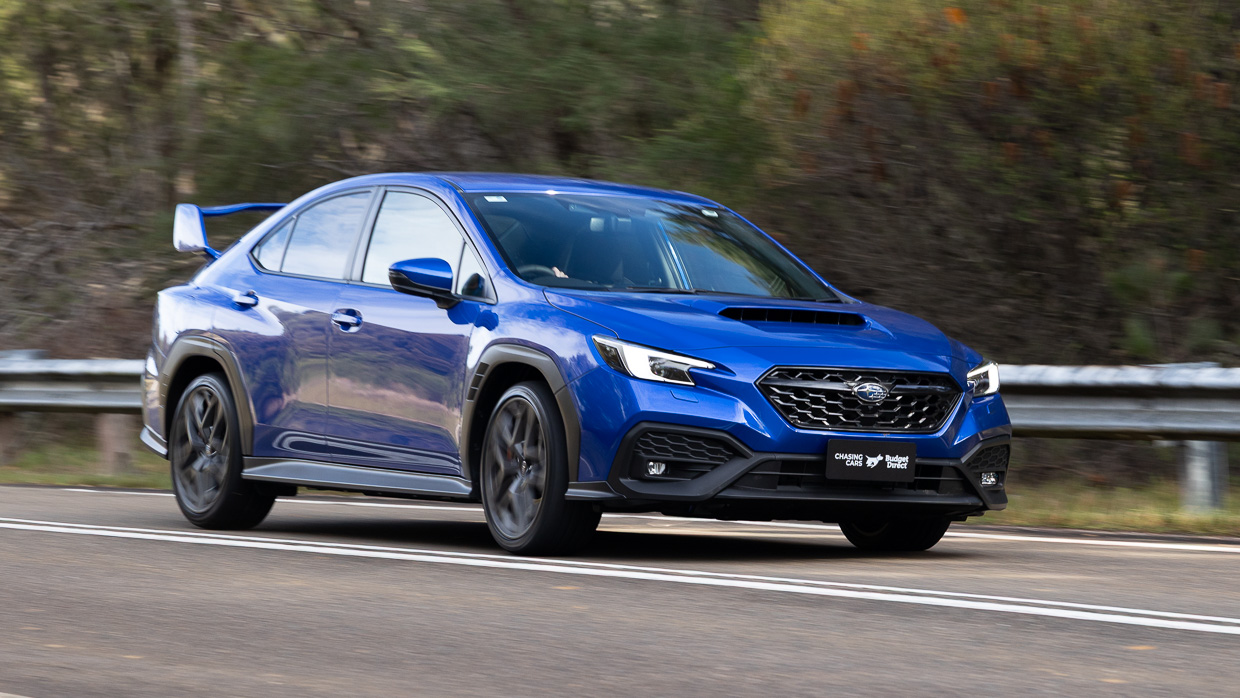
So, boy, the tS Spec B is quite a surprise. It’s very good, partly because it’s quick, partly because it’s got a real sting in its tail, but mostly because it’s about the most integrated and synchronous performance package I can recall in a regular WRX…pretty much ever.
Still, it’s not a proper STI by another name. Even if, in some areas, it gets pretty close.
At 202kW and 350Nm, today’s 2.4L boxer outpunches the old bug-eye’s (harder-strung) 2.0L on the numbers. And at 1522kg, the Spec B is probably just as quick — interestingly, Subaru makes no acceleration claims for its 2025 champion grade.
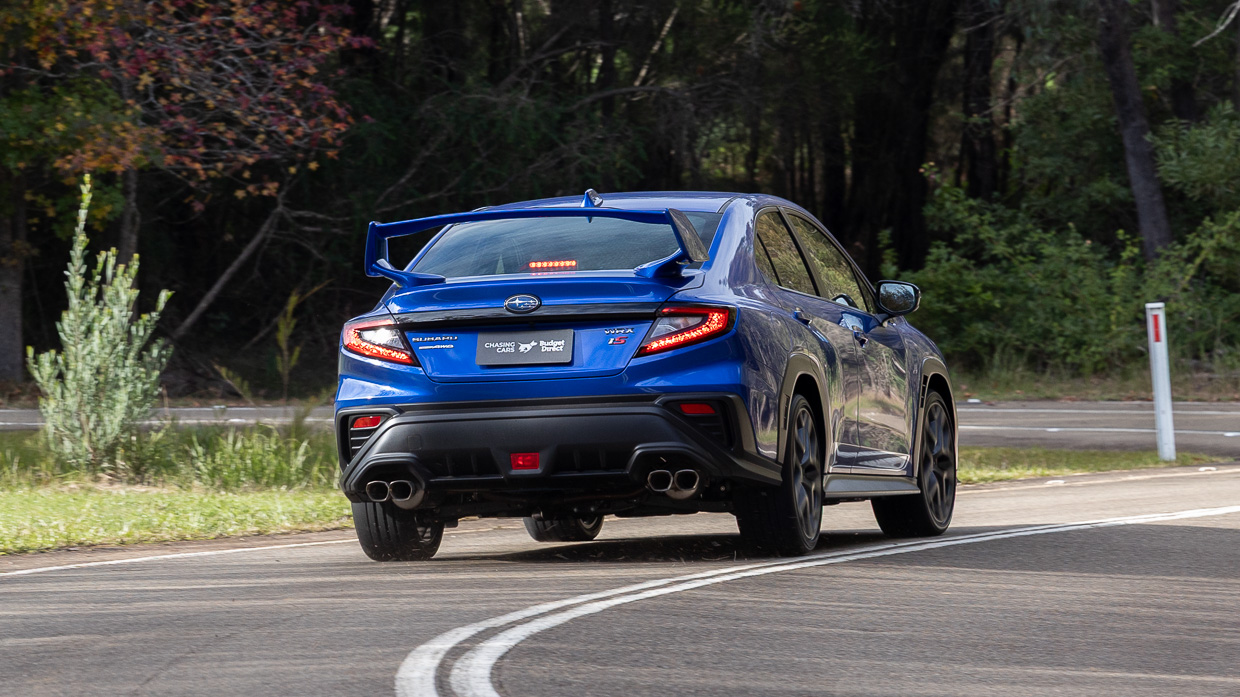
So STI-like potency is there, but where this particular boxer shines is in tractability. Where so many boxer forebears lacked low-rpm inertia — prone to stalling unless you’d prod the throttle off the mark — this 2.4 has natural torque off idle that ramps up nicely to where its peak starts at 2000rpm.
Paired with a strong if progressive clutch, it’s easy to move slowly or swiftly off the mark, its short 4.4:1 final drive bringing punch and purpose on tap.
With its short throw, tight gates and positive nature — real shades of older STI transmissions — the six-speeder feels slick enough for serious action and tough enough to withstand clutch dumping theatrics if the driver sees fit.
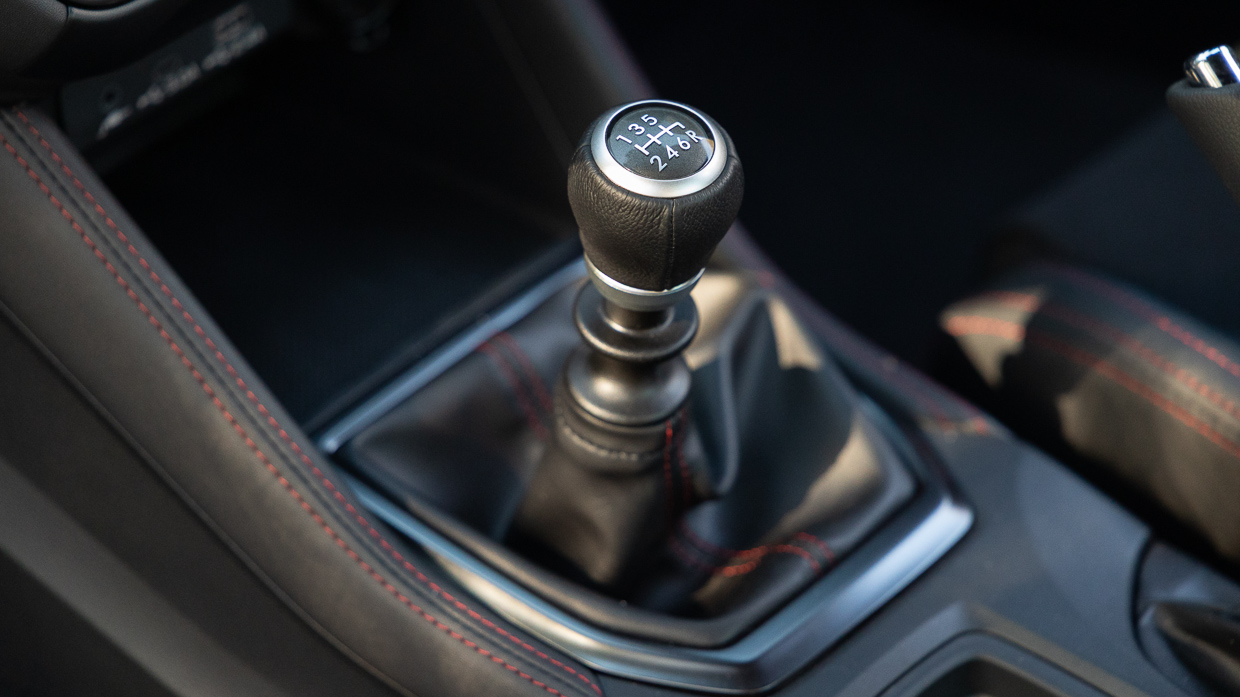
This taut, terrific, almost STI-lite powertrain nature is matched nicely to the strong, progressive feel of the six-piston Brembos.
These anchors feel vastly superior to even some older STI spec, which could lack bite and retardation power. There’s definitely a newfound, honed fitness to this WRX formula.
The theme continues to the steering. Too leaden in Sport calibration if more fluid and nicely measured in with higher Comfort assistance.
And the direction finder is paired with a front end that does a fine job of milking serious — and progressive — dry-running grip out of licorice-thin 35-series Pontenza S007 tyres.
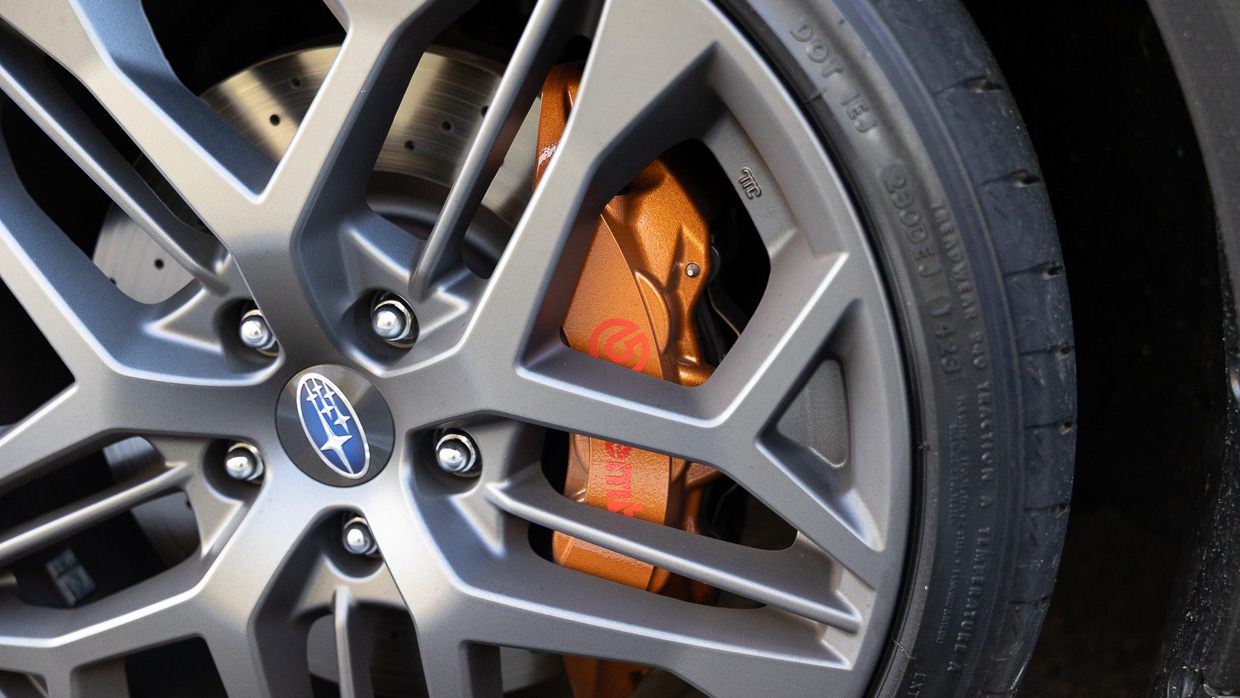
There’s natural balance, too, in the chassis, with both axles firmly in sync, drumming up an innate sense of control and precision at the helm.
Again, there’s a genuine synergy to the Spec B’s dynamic elements well above the old WRX norm — it not only makes this variant hugely driveable but confidence inspiring when you really grab its scruff hard.
Once you do, it’s wickedly quick and plenty of fun. The ‘walk’ it delivers certainly lives up to the boy- or girl-racer aesthetic the Spec B flaunts.
And when you do overstep the tyre friction, the combination of the viscous centre differential and torque vectoring smarts do a fine job of channeling the torque to the corner of the chassis that needs it the most.
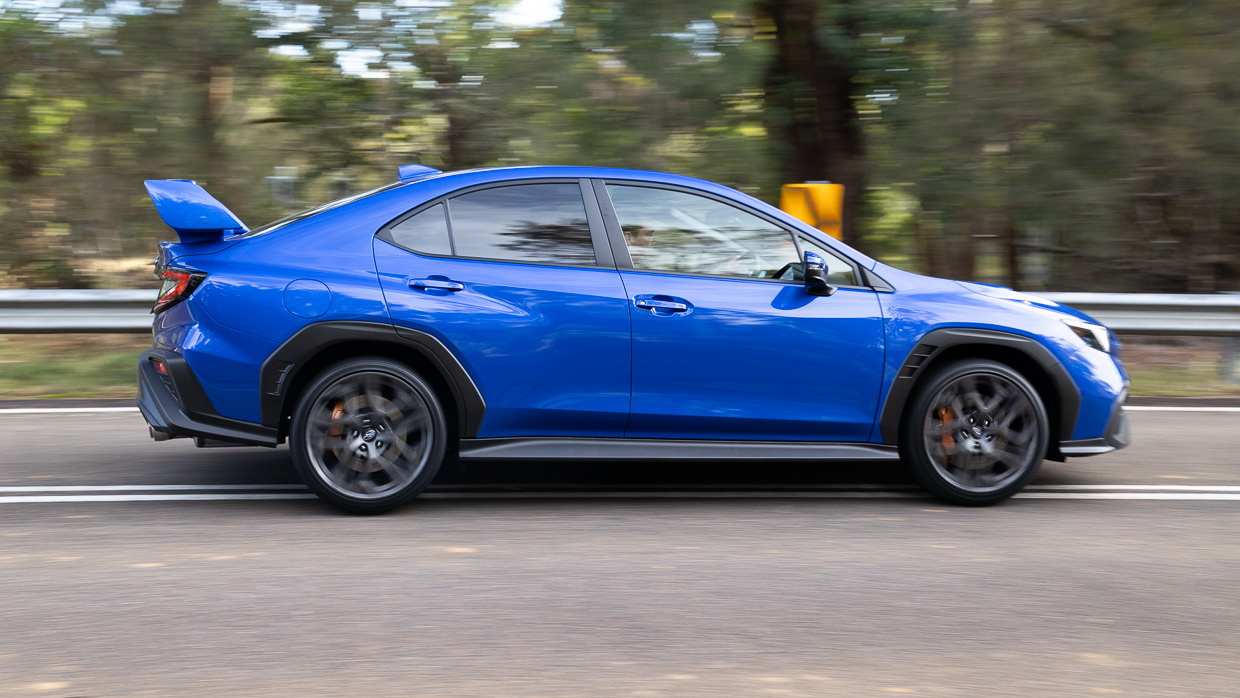
But…the bond-fide STI heroics are missing. The old Torsen axle differential and DCCD (driver controllable centre differential) trickery, that would make the chassis really come alive once you broke traction and grip on any surface, sealed or slippery, just aren’t parts of this regular WRX’s DNA.
As a firebreathing proposition, the Spec B has its technical limitations.
The real surprise is the ride comfort. The Spec B defaults in start-up in Sport, and the firmest of three damper settings. Even then, one member of the Chasing Cars crew who drove it remarked on how compliant it was around town.
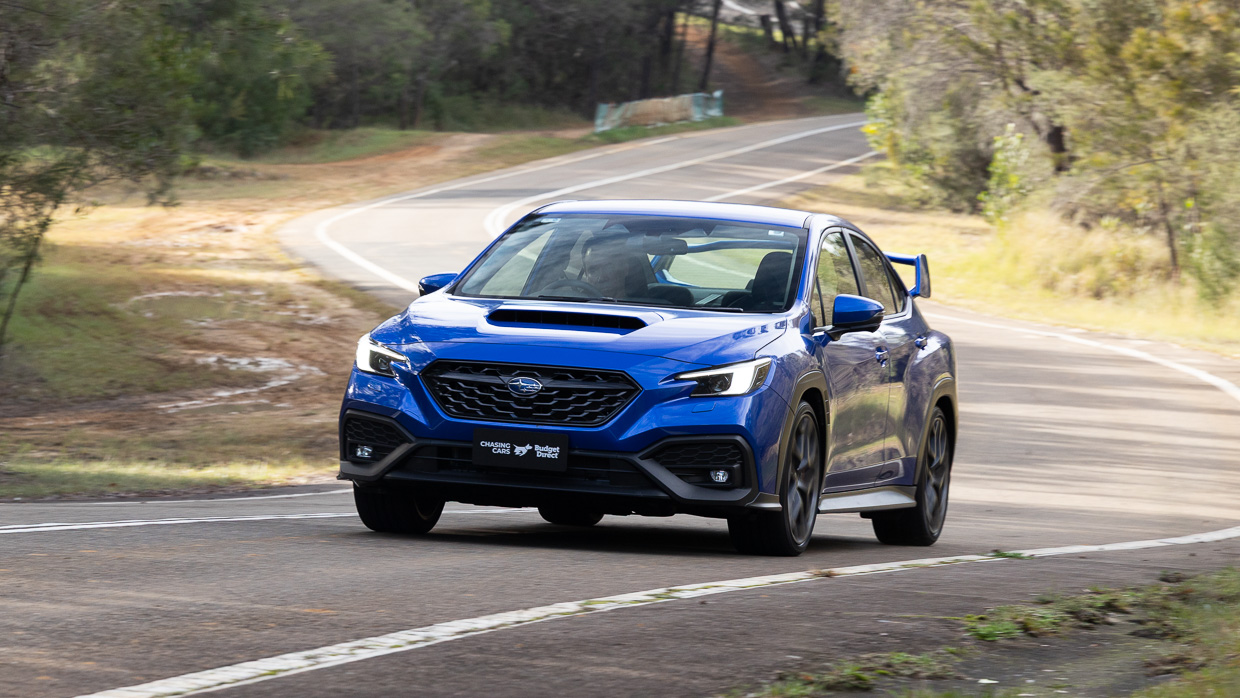
Set to its softest setting, this WRX has — without intended exaggeration — nicer ride comfort than half of the SUVs I’ve reviewed over the past few years.
The cooperation and sheer drivability of the powertrain combined with the exceptionally pleasant around town and touring manners really do make the Spec B, in particular, possibly the finest all-rounder ever to wear an WRX badge.
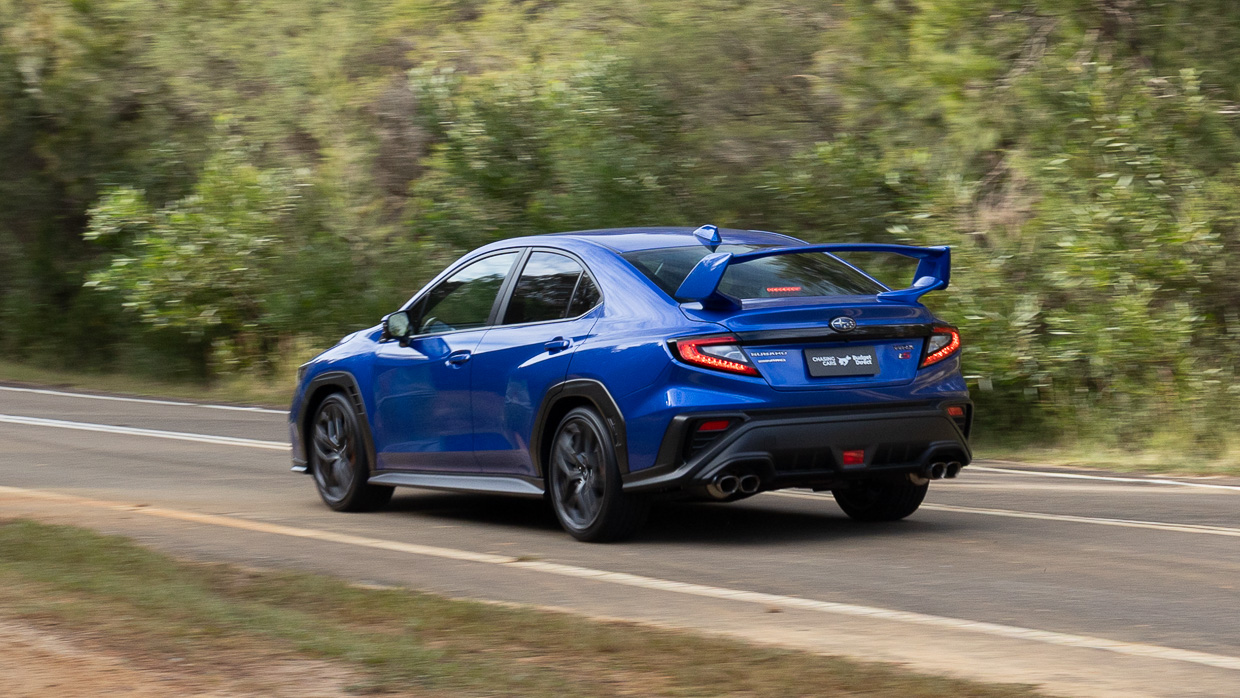
While the preferred ‘attack mode’ essentially taps Sport for powertrain and suspension tuning while resorting to Comfort for steering, the ‘everything soft’ Comfort drive mode preset makes the Spec B incredibly easy to live with — much more so than terser alternatives in the Hyundai i30 N or Honda Civic Type R.
In fact, the Spec B’s manual-and-adaptive suspension combination is such a sweet Jekkyl and Hyde that it’s a real shame that Subaru doesn’t choose to offer it in a more family-friendly five-door Sportswagon form.
What is the WRX tS Spec B’s interior and tech like?
The classic, old-school charm that today’s 2025 WRX carries on road continues through to the cabin, for better and for worse.
The fitment of Recaro-branded bucket seats has been a go-fast flex for Subaru (and other Japanese makers) dating back decades, so often to a result that feels more simply bolted in than properly ergonomically integrated by design.
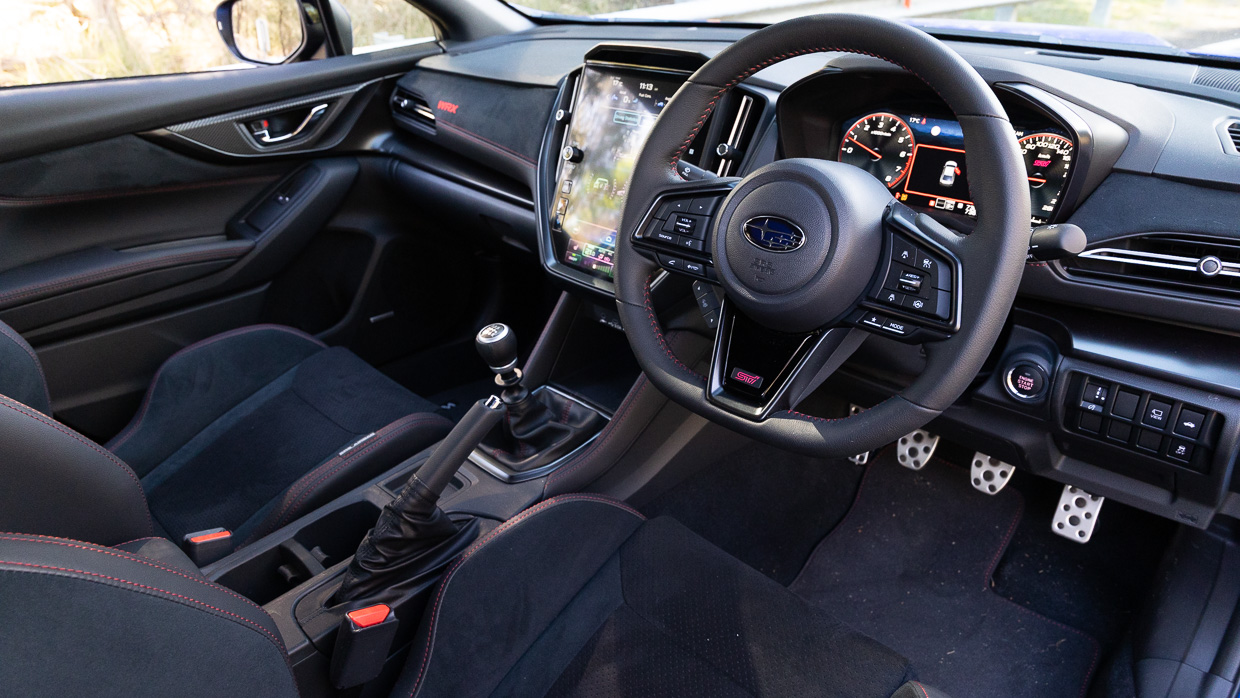
That’s the case here — they’re not quite a glove fit for the cabin — though issues are perhaps with the seats themselves.
These seats are unforgiving, wedging your thighs and welding your ribs with bolstering. The bases are short, lacking under-thigh support and, worse still, the seat backs are incredibly stiff.
They’re just form-fitting enough to alleviate the need to visit a chiropractor after a long Sunday morning b-road punt…just.
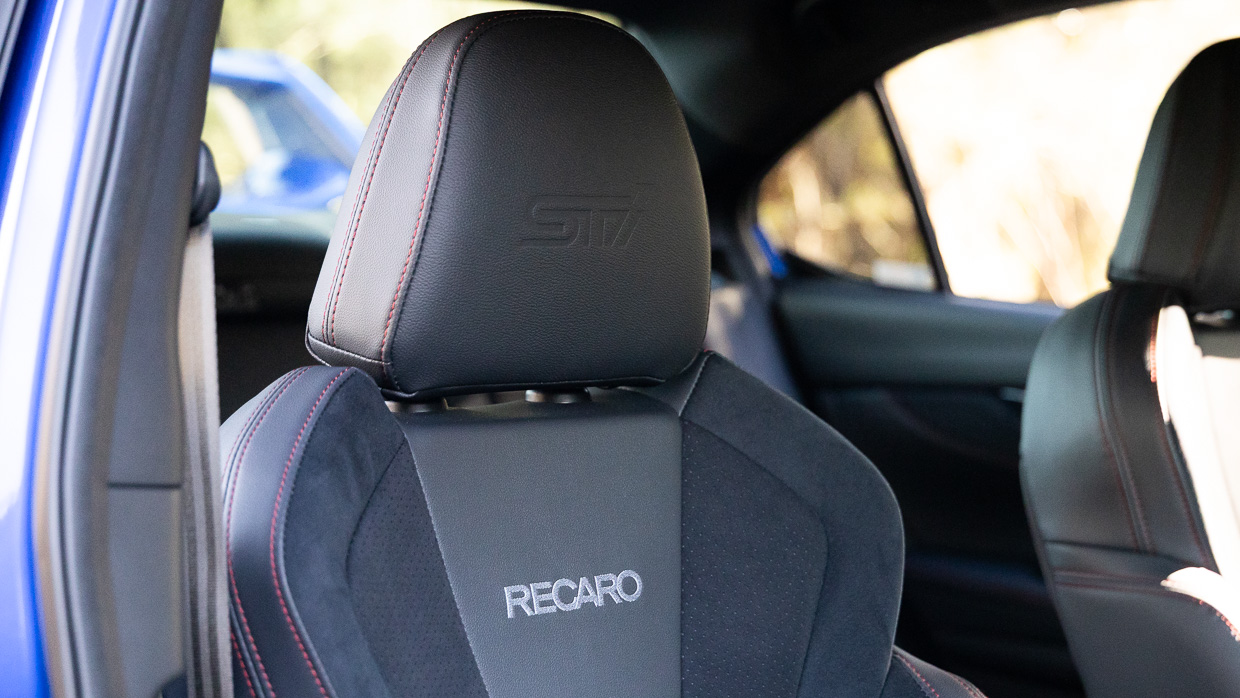
Elsewhere, the design ethos could be a decade old, though no Subaru model is a pillar of contemporary slickness or minimalism. At least it feels familiar and oh-so traditional WRX.
The new-for-WRX 12.3-inch driver’s screen brings some brightness to the darkened near-black cabin theme, which is at least punctuated with splashes of faux suede, not-really-carbon-fibre detailing and stacks of red double stitching.
But sharpness, skin design and content aren’t the driver’s screen’s strong points.
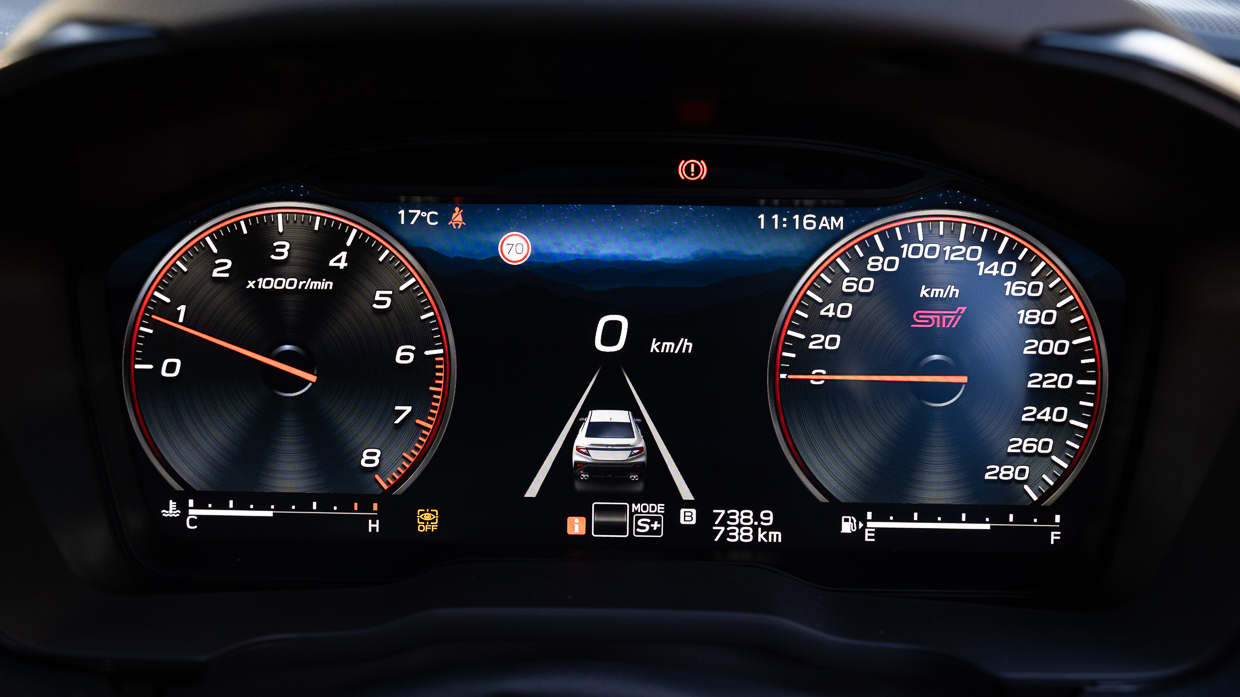
Ditto the 11.6-inch touchscreen. As is Subaru tradition, the display is overly busy and consumed with a dizzying array of different fonts as the media system attempts to bombard the occupants with all manner of inconsequential information (degrees of vehicle tilt, anyone?).
At least the physical audio dials and climate control buttons in the media screen frame are oh-so convenient to use.
The content is good. Wireless Apple CarPlay worked faultlessly — though wireless phone charging is absent — and the Harman Kardon sound is impressively rich and clear.
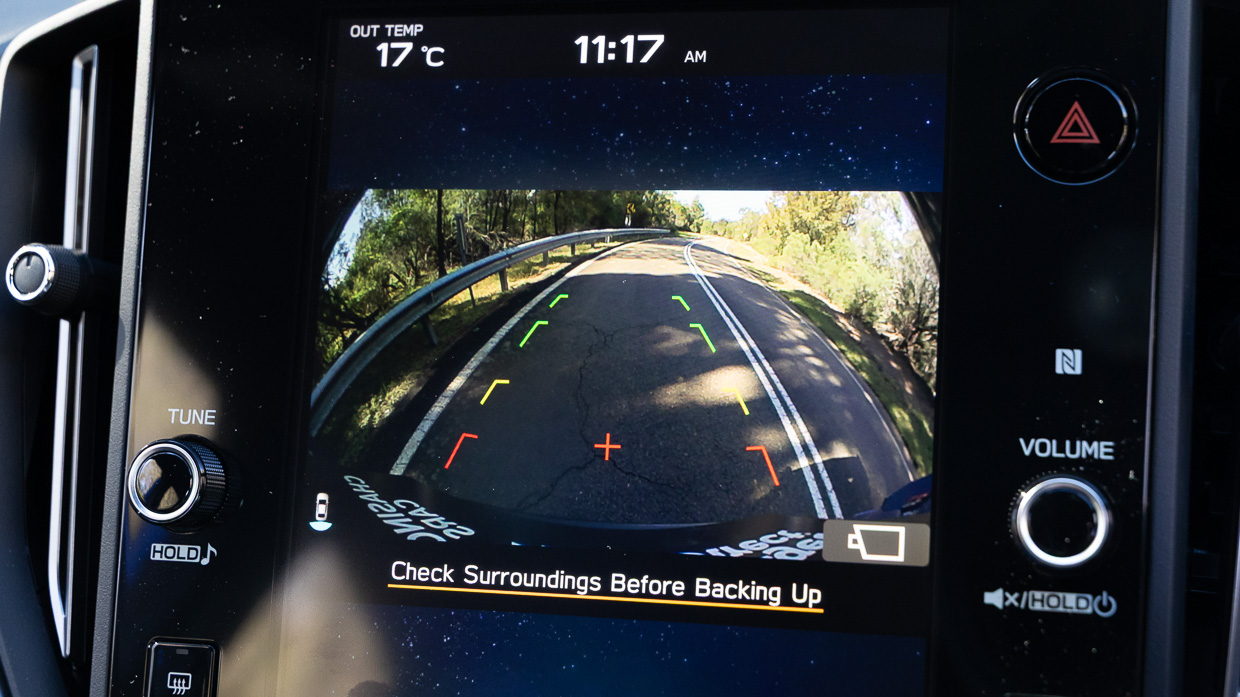

The reverse camera is also decent, though a lack of reversing sensors (or rear AEB) on manual WRXs specifically is a bit of a head-scratcher.
The 17-button multifunction wheel looks lifted from an Outback and the lack of a sportier, bespoke tiller is a bit of a missed trick.
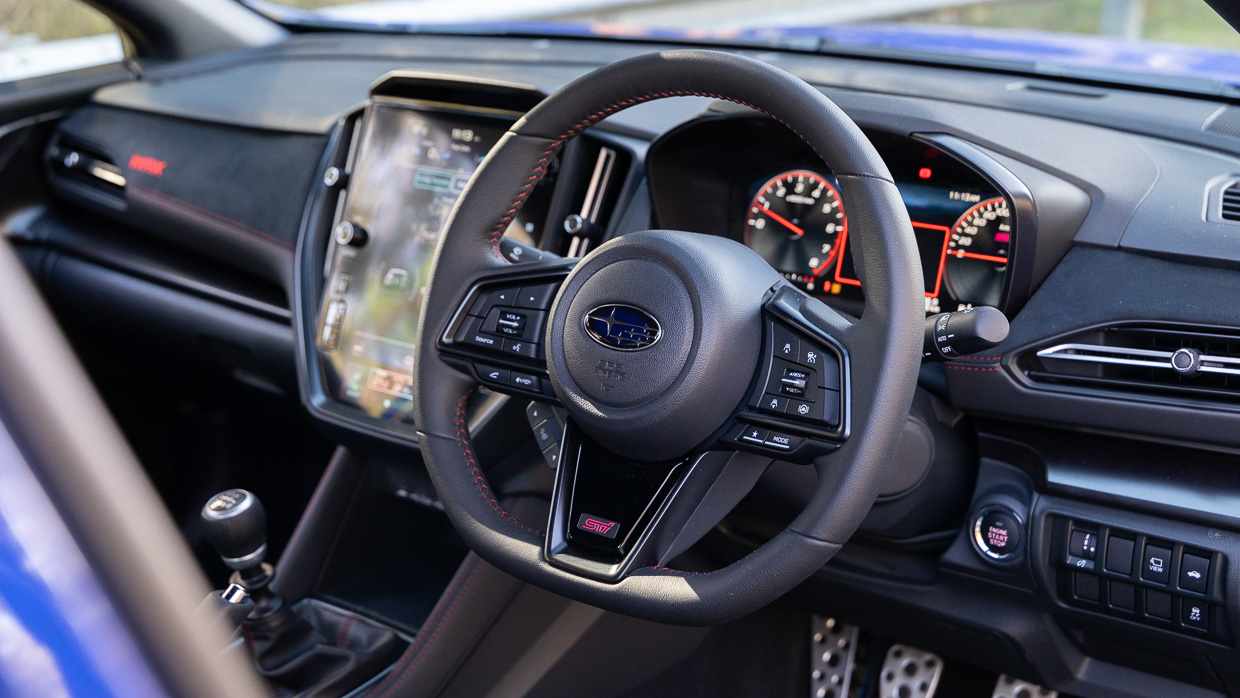
But it remains fit for the heat of the driving battle, right down to the good-old mechanical parking brake that’s a handy ally during motorkhanas and track work.
Row two offers plenty of legroom and feels spacious, though the ceiling lacks the concave depression found up front and as a result — and despite the lack of a sunroof — headroom is quite limited.
But rear occupants do benefit from decent amenities shared with those in the first row, including dual USB ports, flocked doors bins and seat heating, though yet another strange omission is a lack of rear air vents (otherwise fitted to the wagons).


On that, the decent 411-litre boot is dwarfed by the 492L found in the Sportsback that converts to 1430 with row two stowed. No such convenience here.
A space saver is fitted under the WRX tS Spec B’s floor that appears sized to allow clearance for the large six-piston brakes used on the front axle.
Is the WRX tS Spec B a safe car?
While the last-gen WRX scored a five-star ANCAP rating and four of WRX’s stablemates — Crosstrek, Solterra, Outback and outgoing Forester — get full marks, the BRZ coupe and current WRX generation remain unrated.
There’s a broad array of features fitted to the model, though completeness is spec-dependent. Base versions lack Subaru’s EyeSight smarts, and some features, such as reversing AEB, are missing from manual variants.
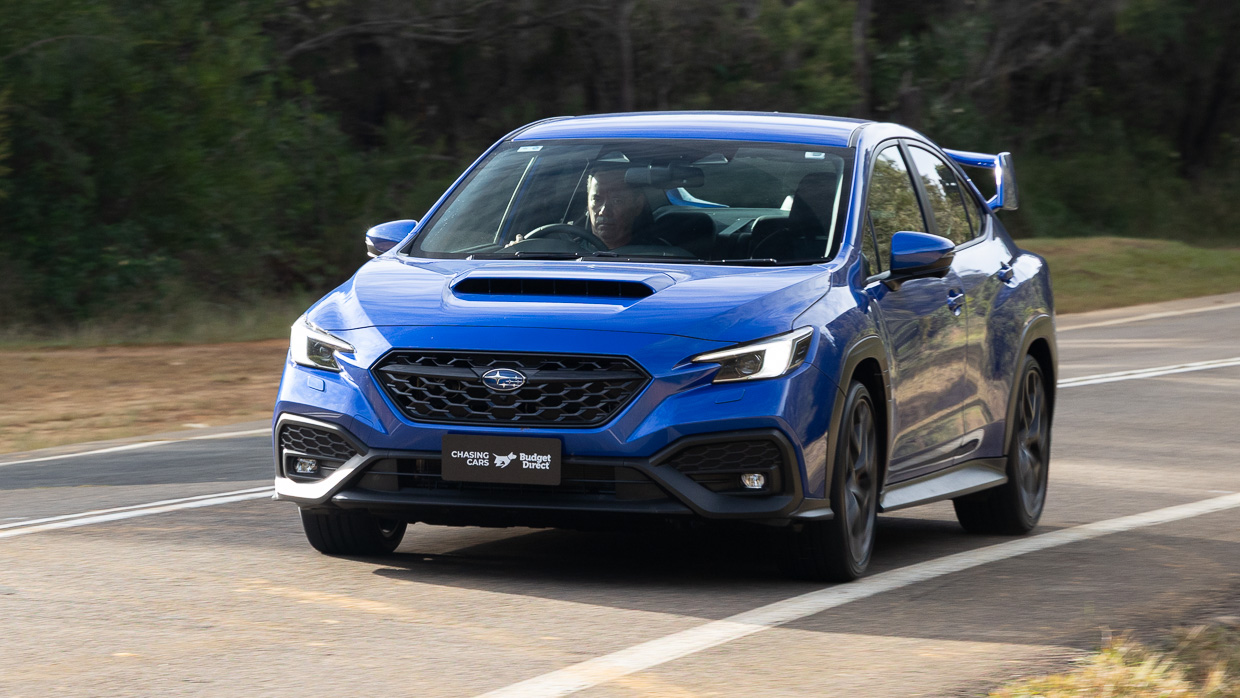
As it stands, the Spec B fits the following specifics:
- Forward collision avoidance
- Autonomous emergency steering
- Driver monitoring system
- Blind spot monitoring
- Lane change assist
- Rear cross-traffic alert
- Side view monitor
- Emergency lane keeping
- Lane centring
- Lane departure warning/keeping
- Lane sway warning
- Emergency Driving Stop System
- Speed sign recognition
- Lead vehicle start alert
- Eight airbags
What are the WRX tS Spec B’s ownership costs?
The Spec B is, by 2025 standards, quite thirsty. The form guide suggests combined consumption of 10.4L/100kms, with an 8.2L highway figure and a sobering 14.2L urban claim.
Our test subject is not only around half-a-litre thirstier than the WRX RS manual sedan — for reasons that remain a mystery given it’s just one kilogram heavier — it drinks two litres per hundred more on a combined cycle and three litres more urban than any CVT sedan of Sportwagon variant.

All WRXs demand a minimum of 95RON premium fuel.
Servicing will cost around $1370 upfront for a three-year plan and $2692 for a five-year plan, with intervals a typical 12 months or 15,000kms between visits.
Warranty is a fairly typical five years of unlimited-kilometre coverage.
The honest verdict on the WRX tS Spec B
Is it any good? Absolutely.
And given your reviewer had lost faith — especially in regular WRX stock — over a very long stint, the form of the fittest example of the latest generation comes as a bit of a pleasant surprise. The Spec B really is better than we were expecting.
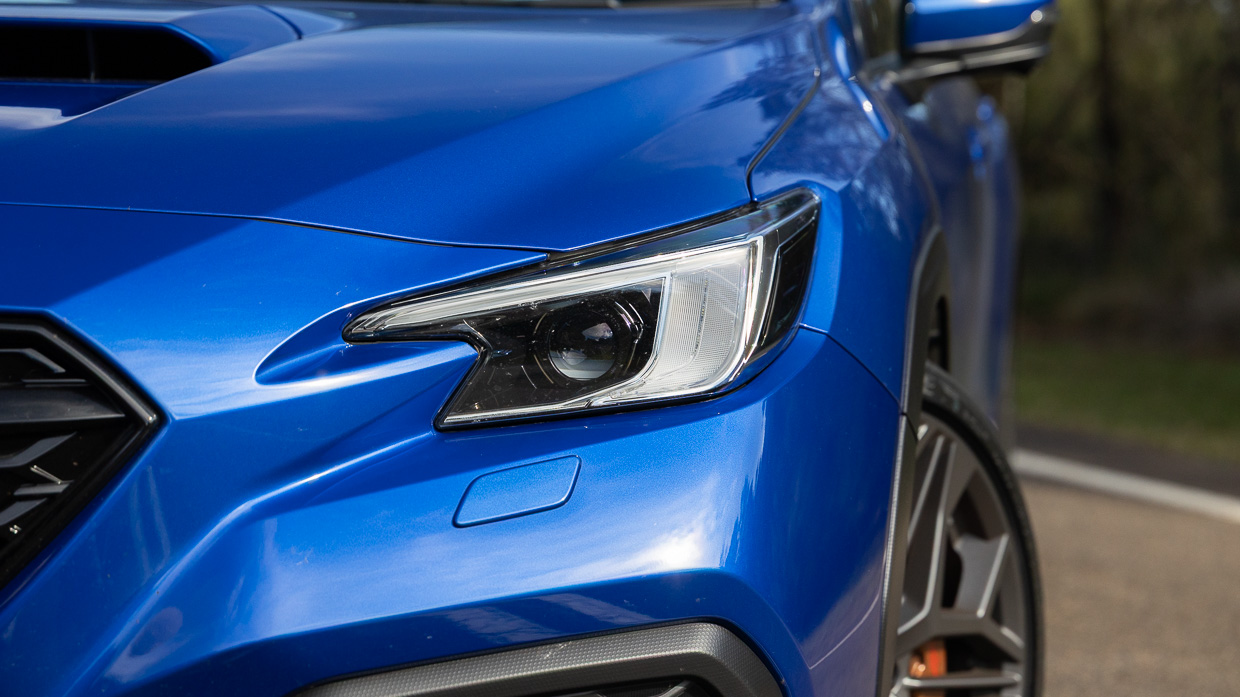
Is it anything like a classic STI experience? For strung-out red-misted talent, not really. But for back-road pace and solid fun factor in an endearingly old-school package with impressive new-school resolve, it comes much closer than anticipated.
Better yet, we cannot recall any WRX that’s nearly as fine an all-rounder while maintaining the soul that WRX had for so long traded off. If this isn’t the best WRX yet, it’s been a long, long time since Subaru has executed one this good.
Is it worth its premium? We’re inclined to think so.
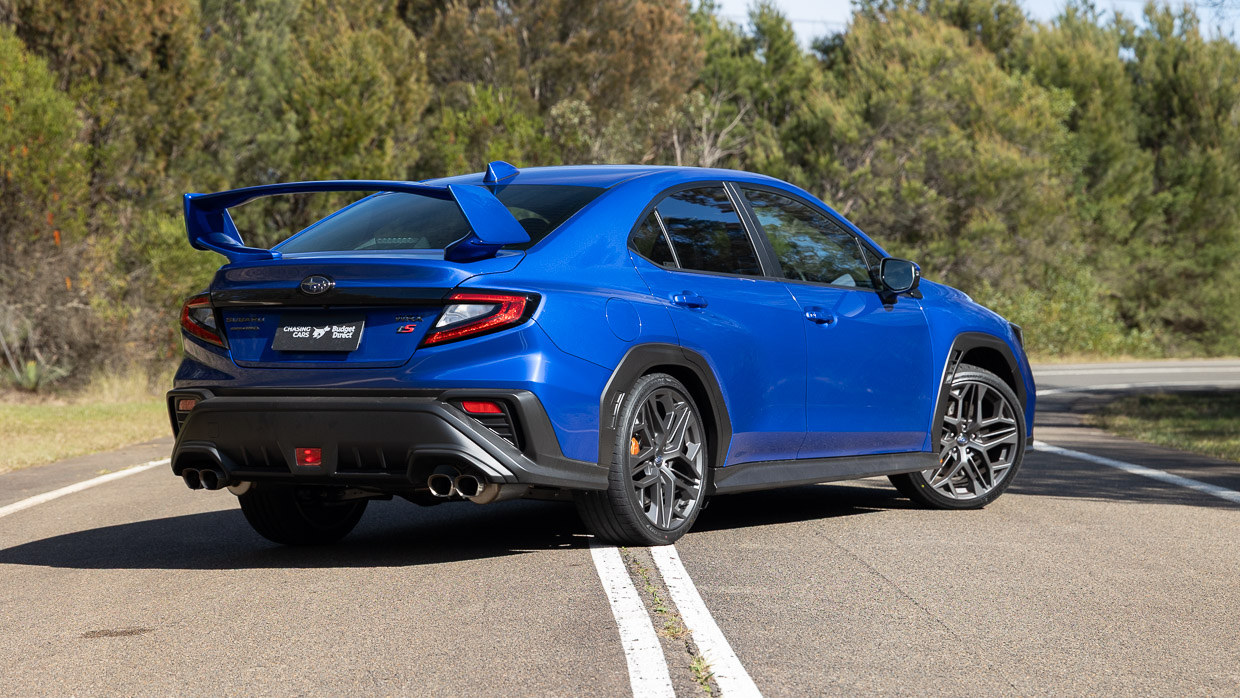
It’s a shame Subaru diluted some of the Spec B exclusivity by porting the Recaros and driver’s screen to all tS variants but…the other two options are no cheaper as a buy-in. And, besides, a real WRX deserves a proper manual ’box anyway…
Strike the tS Spec B up as a resounding win, especially for the gearheads among us who lament the shrinking landscape of conventional turbo-charged go-fast machinery.
Let’s hope Subaru can make it a trifecta by adding the illusive manual Spec B Sportswagon variant, and finding justification to once again cook up a pukka WRX STI.
MG QS Essence 2025 review
3 months ago

John Law
Road Test Editor
Looking to address gaps in its range on the way to sales domination, MG has rushed its new seven-seat QS to market
Good points
- Impressive adaptive damping
- Plenty of cabin space
- Light, accurate steering
- Affordable to buy
- Surprising handling proficiency
Needs work
- Obstructive technology
- Rushed RHD conversion
- Dull-witted drivetrain
- Cabin noise suppression
- Unwieldy back doors
- Costly servicing
Looking at sheer sales numbers, MG is doing well in Australia, though in the first half of 2025 it has slipped behind a fast-rising GWM in the local leading-brands chart.
New, diverse product is always a good market trick to stem a sales deceleration, and that’s exactly what MG is doing, speedily plugging gaps in its range. The QS is the latest gap-plug for the British-named, Chinese-owned brand.
Targeting the Hyundai Santa Fe, Toyota Kluger and Kia Sorento, the MG QS is going after big Australian families with three rows and space for seven in its near-five-metre body.
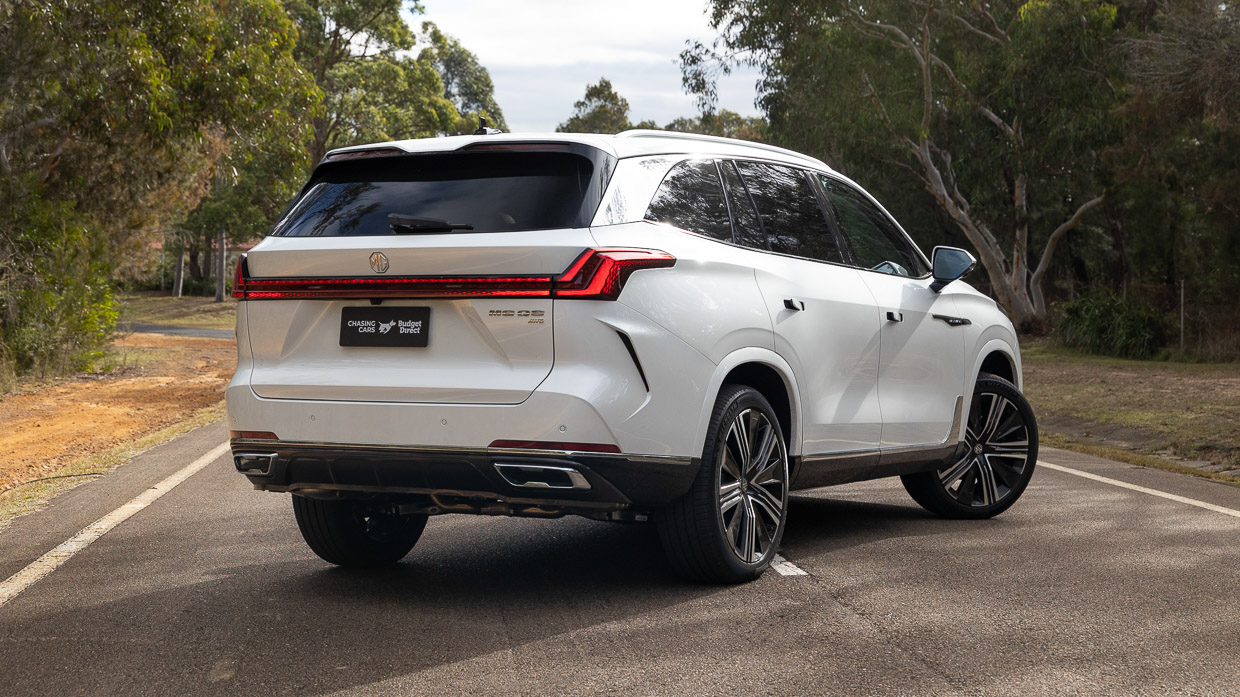
Australia is the first right-hand-drive market to get the freshly named QS, but if it looks a little dated inside and out, that’s because it is. In China, this vehicle is sold under the luxury arm of SAIC (MG’s parent company) known as Roewe. It’s also sold in the UAE as the MG RX9. A similar solution as MG came up with for its RAV4-fighting HS mid-size SUV.
The QS has been very lightly MG-ified – really only the front badge from what we can see. It carries the same Hyundai Palisade meets The Joker grille and tacky plastichrome addenda as its Chinese and Middle Eastern counterparts.
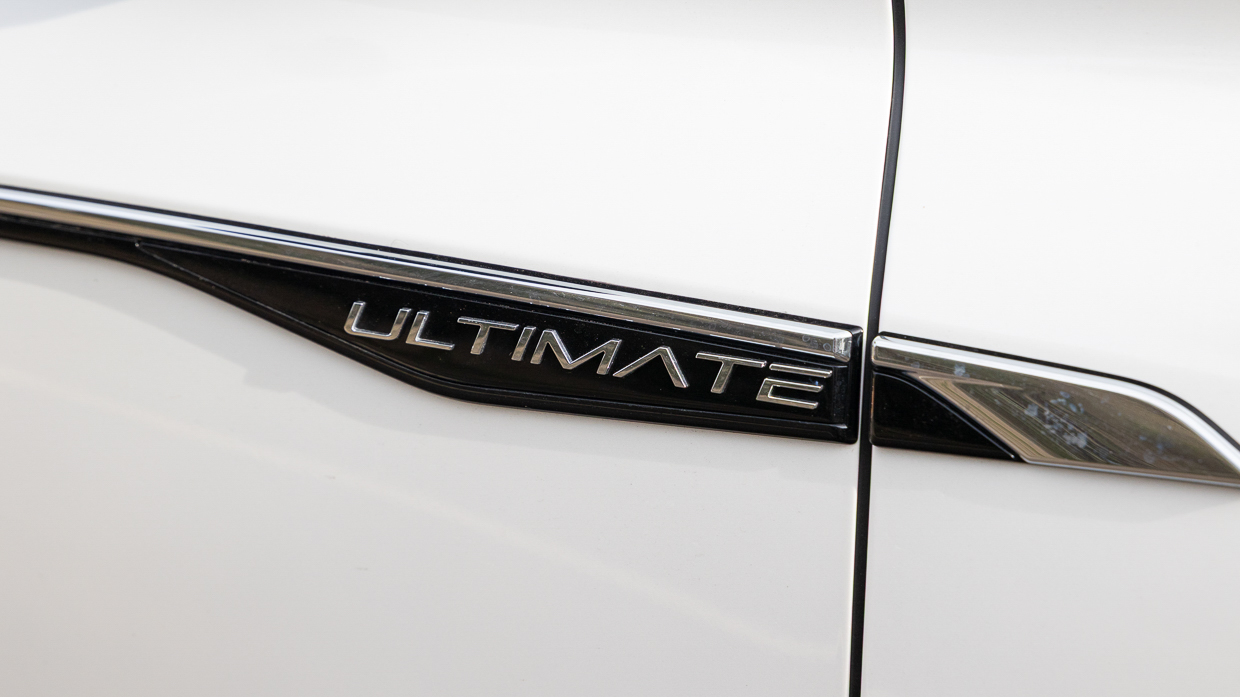
It even has ‘ULTIMATE’ in chrome on the guards, despite that carrying absolutely no meaning in the Australian market, where MG sells two trims known as Excite and Essence.
The question is whether the QS can deliver a convincing overall package that can help overlook its chintzy appearance.
What are the QS Essence’s features and options for the price?
The MG QS arrives in Australia in two trims: entry-level Excite and top-spec Essence. Both use a 2.0-litre turbo-petrol four-cylinder developing 153kW and 360Nm, the key difference being driven wheels and level of equipment.
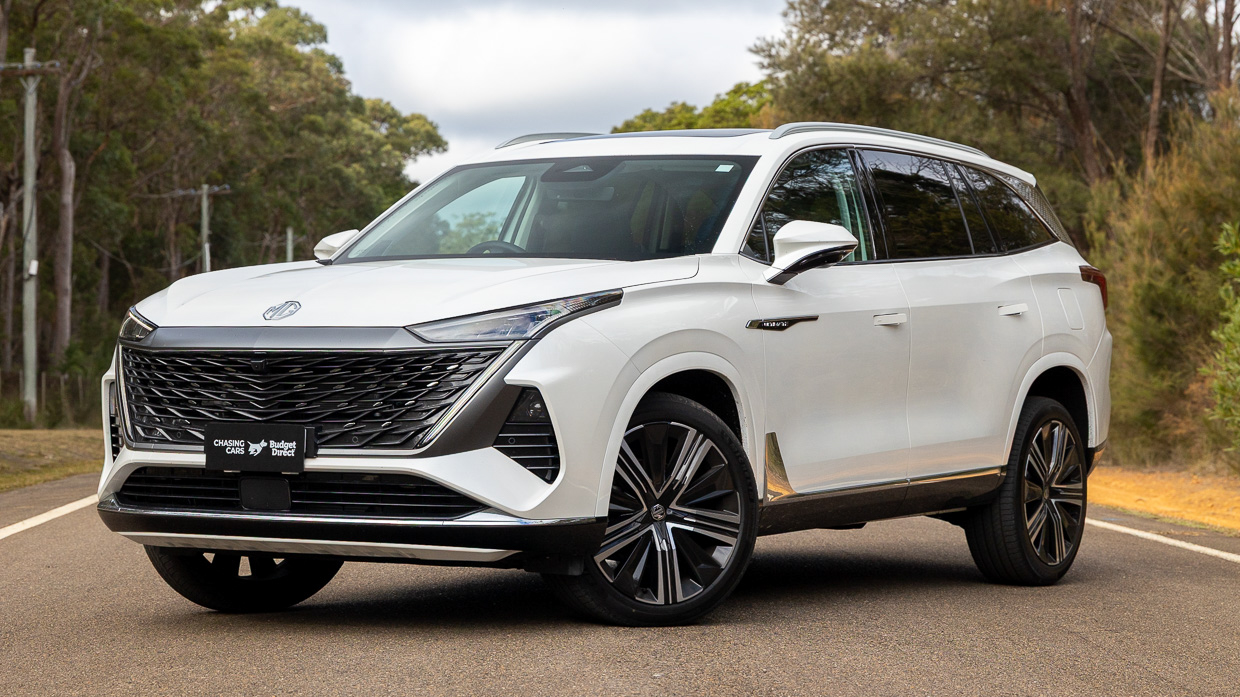
The Excite is front-drive only and is on offer at $46,990 driveaway nationally. Moving up to the Essence is $4000 well spent in our book, adding the security of all-wheel drive along with adaptive dampers.
Below is a list of features in the QS Essence, with bold text denoting an upgrade over the Excite.
- 21-inch alloy wheels
- LED headlights
- Auto highbeam
- Customisable welcome greeting
- Keyless entry w/ push-button start
- Synthetic leather-appointed steering wheel
- 256-colour ambient lighting
- Panoramic, opening sunroof
- Tri-zone climate control
- Heated rear windows
- 12.3-inch digital driver’s display
- Navigation with cluster display
- 12.3-inch multimedia touchscreen
- Wireless Apple CarPlay and Android Auto
- 12-speaker Bose stereo
- Wireless charging pad
- Front parking sensors
- Perforated leather-faced upholstery
- Heated and ventilated seats
- Heated steering wheel
- Eight-way power-adjustable front seats
- Power tailgate
- Adaptive dampers
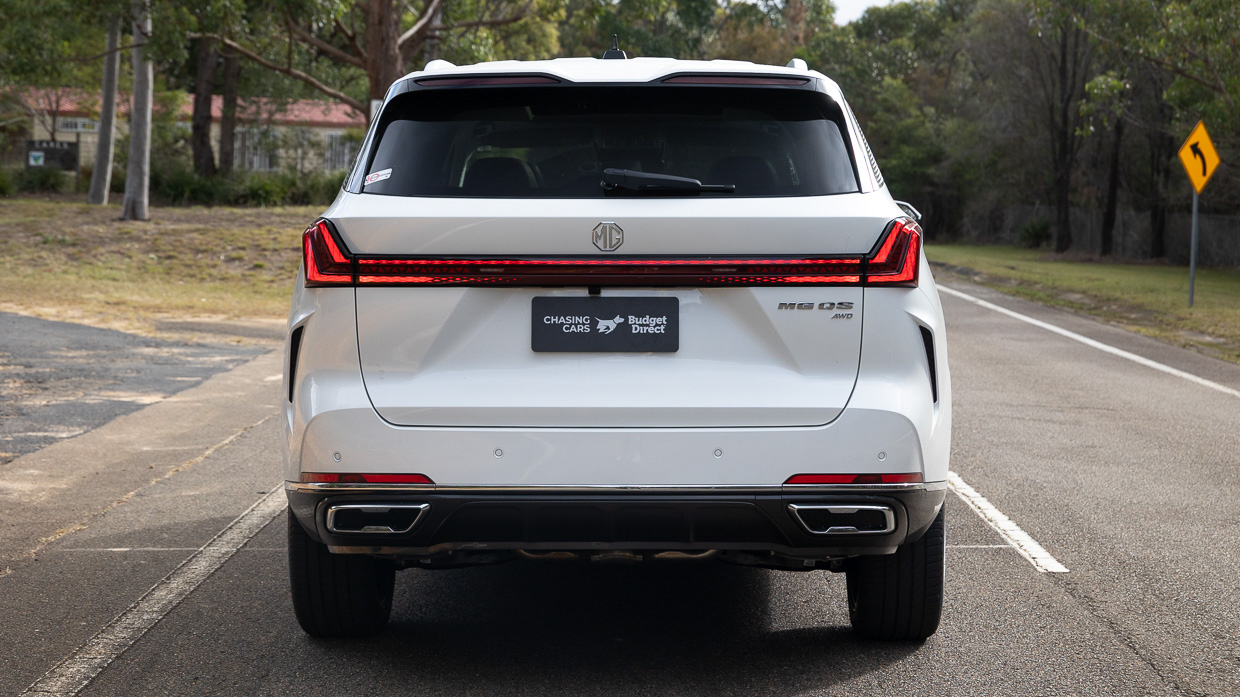
And if you’re thinking those prices sound like they’re from a decade ago, it’s because they are. Seven-seat large SUVs are dear these days. There’s an exception in the $38,990 driveaway Chery Tiggo 8 Pro Max, but it is much smaller, measuring more than 26cm (263mm) shorter than the 4983mm-long QS.
Really, then, the QS competes with the Hyundai Santa Fe (from $53,000), Nissan Pathfinder ST-L ($59,945), Kia Sorento S ($50,880) and rather expensive Toyota Kluger GX hybrid ($62,140). (Prices listed before on-road costs and current as of mid 2025.)
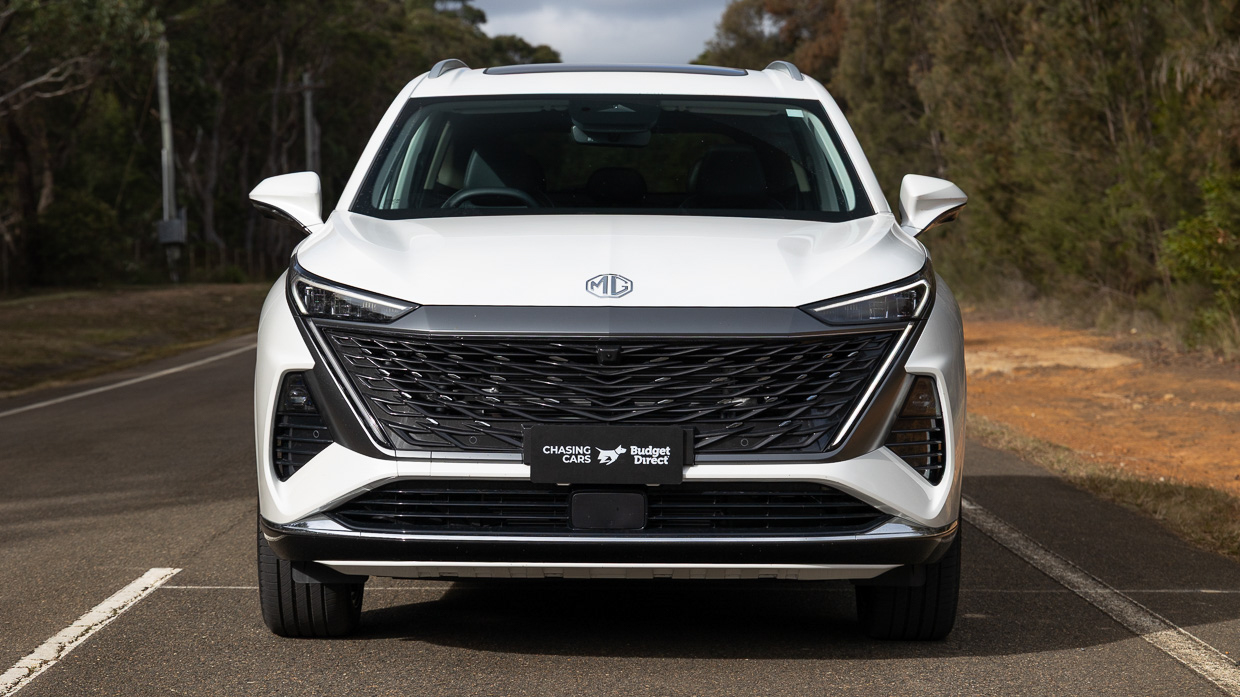
Each of those rivals has more polish and greater breadth of choice including eight-seat (Pathfinder) and hybrid (the others) options, though. BYD’s upcoming three-row Sealion 8 plug-in hybrid may be worth waiting for, however.
How does the QS Essence drive?
There’s some excellence in the QS Essence driving experience, exceeding our class benchmark Hyundai Santa Fe in terms of ride sophistication and road-holding. It’s a shame that level of polish is so fleeting, leaving the QS feeling deeply unfinished.
The secret is the Essence’s adaptive dampers. A total of six drive modes can be cycled through with a rotary selector, including Auto, Eco, Custom, Sport, Snow and Off-road. And in Auto or Eco, the way the QS breathes with the road and controls its considerable 2030kg mass is very impressive.
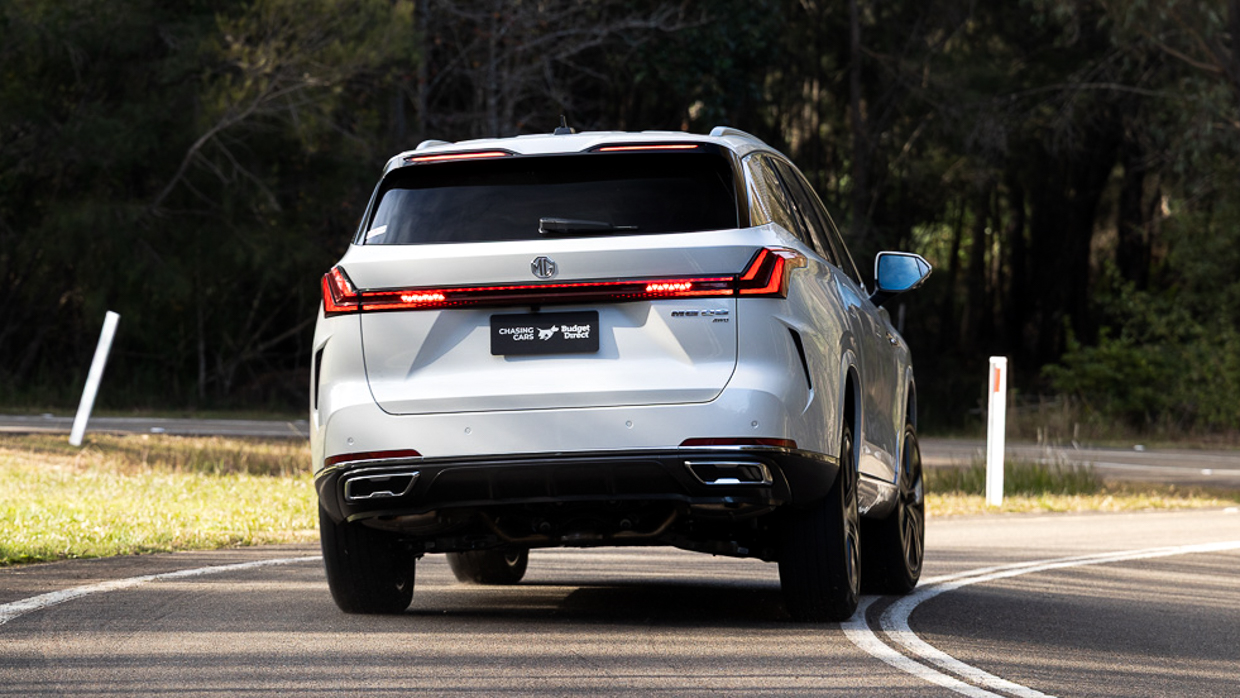
Doubly so because the QS rides on huge 21-inch alloy wheels, which are wrapped in quality 255/45 R21 Michelin Primacy E EV-targeted tyres. That said, the ride on 19s would have been even better along with minimising road noise and the QS’s pronounced bump-thump.
Choosing good tyres and having trick dampers means the QS corners flat and handles well, enabling a small amount of adjustment through the rear end you’d never expect in a big bus like this.
But this is where effusive praise for MG’s new seven-seater ends, because the rest of the driving experience is flawed. The 2.0-litre engine’s note is hollow and buzzy, especially from cold.

The QS’s nine-speed automatic transmission is recalcitrant and clunky, always going for the highest ratio when cruising, blunting response. It gets lost when the lights go from red to green as you’re coasting towards them and clunks into a low gear.
Then there’s the lag off the line. With the auto stop-start system left on, you’re waiting almost two seconds before anything meaningful happens (and which got me a toot from a car behind on one occasion).
Part of the problem is the MG’s power delivery. The peaky 2.0-litre has to work hard to reach its 153kW and 360Nm maximum outputs, so it never feels effortless unlike the Hyundai Santa Fe’s tractable 2.5. The QS managed to get from 0-100km/h in 8.9 seconds in our testing, which is on the slow side these days.

While on performance testing, the QS did shine in passive safety. The body remains poised under heavy braking and evasive manoeuvres, too. The QS posted a strong 100-0km/h stopping distance (34.75 metres) and kept a predictable pedal feel over three hard stops.
It’s a mixed bag, the QS, but rather than the impressive damping, it’s the lows of a lazy powertrain and noisy cabin that you remember most.
What is the QS Essence’s interior and tech like?
Labelling the QS a family bus is pretty accurate, especially when talking about the elevated driving position. With its steering wheel tilted away from the driver, pedals set close and a tall bonnet line, it also feels claustrophobic.
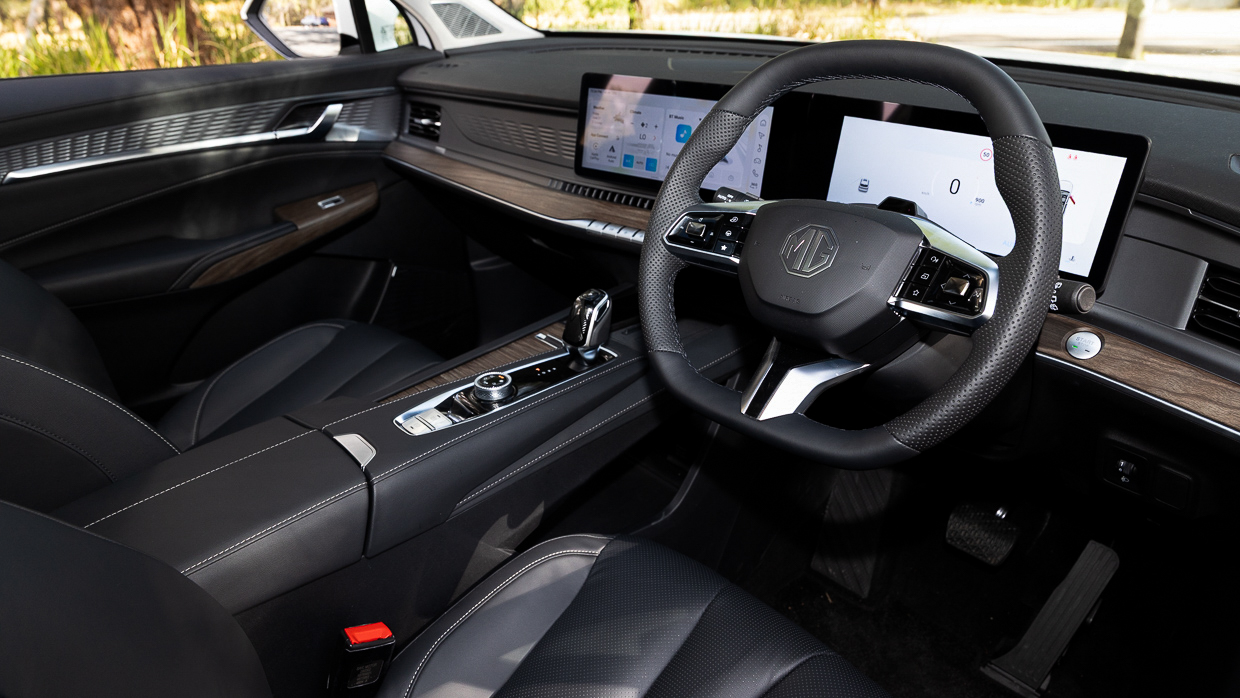
The perforated (real) leather seat facings are nice for $50K, even though the lazy-boy seats lack under-thigh and lateral support. That squishy feeling is common around the cabin, with soft dash and door topping and armrests giving a sense of new-luxury.
It’s a thin impression that breaks with the Bose 12-speaker sound system. MG seems to have purchased the speaker grilles and left the rest behind because the sound quality is disappointing, with a muddy bass and thin tone. The saving grace is that it goes really loud, if you like that kind of thing.
Where the QS really struggles is technology. The central touchscreen is a respectively sized 12.3-inch unit but MG has jammed everything in there. From key vehicle controls like safety systems to the climate adjustment, to the heated steering wheel and heated/ventilated front seats.
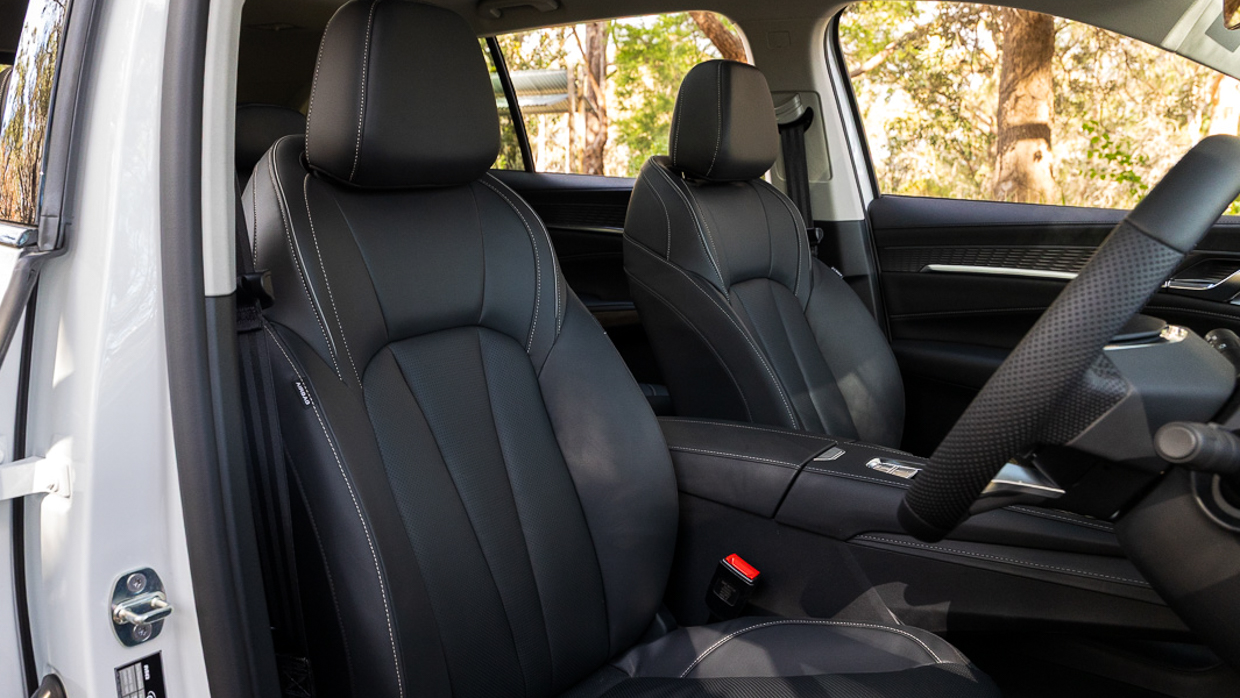
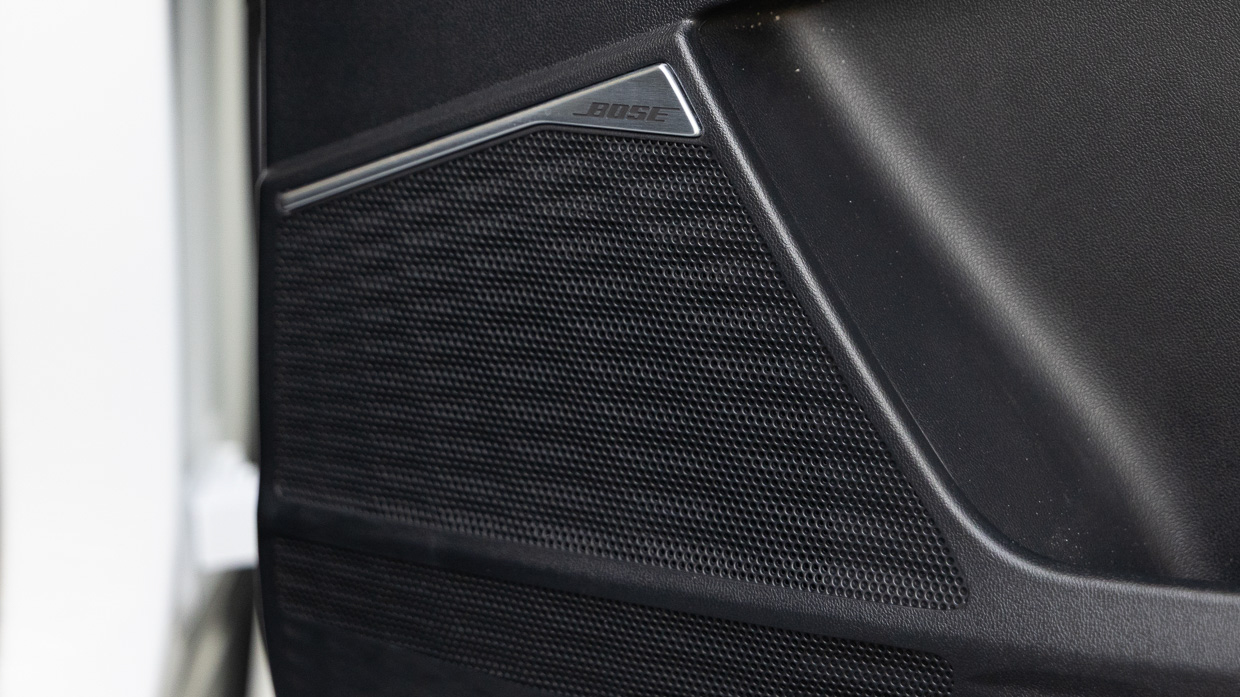
There’s a pull-down shortcut menu through which you can disable the lane-keep assist, auto stop-start and other features, but it isn’t customisable – meaning you need to tap four times from wireless phone mirroring to get to the heated seats.
Also, the direction of the central vents is adjusted through the touchscreen, like a knock-off Tesla Model Y. It might not be so bad if the QS had a responsive touchscreen, but the processor responds at random – mostly glacial – times. It’s tiring, distracting, and borderline dangerous.

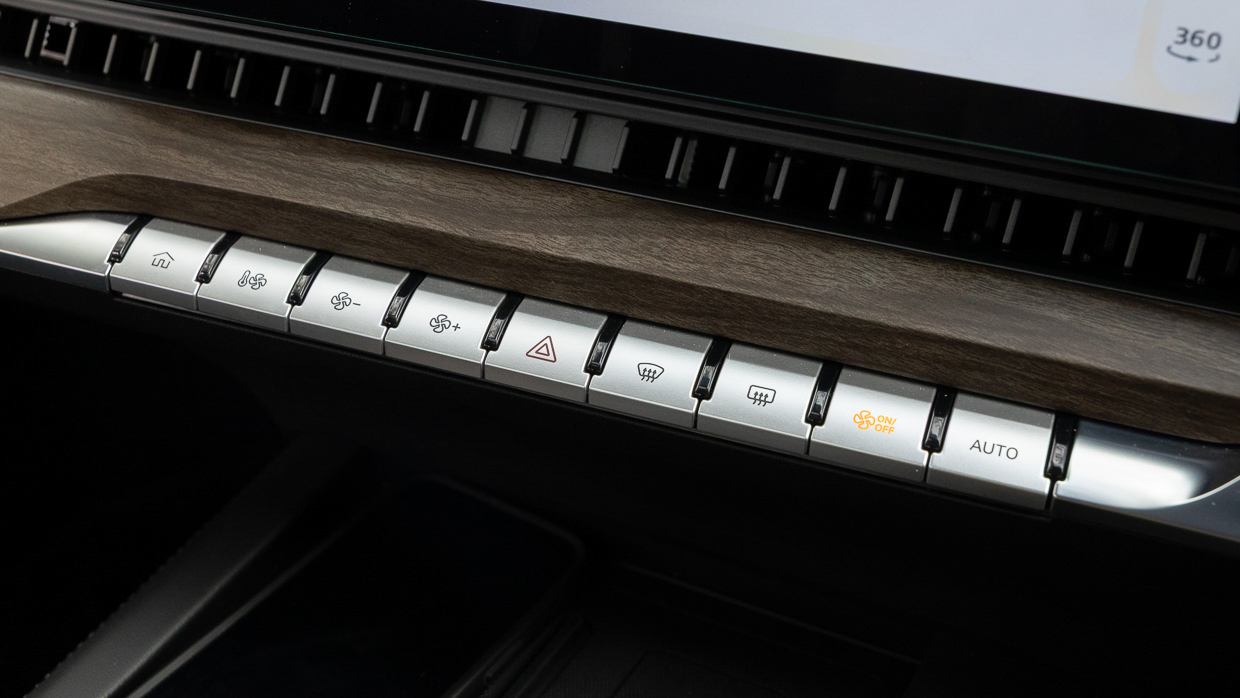
Front-seat storage is good, with a deep centre bin, door bins that accept small 600mL bottles, and two cup holders with pseudo-Formica roll-top cover. Beneath the shift-by-wire gear selector is a storage tray good for tissue boxes or handbags.
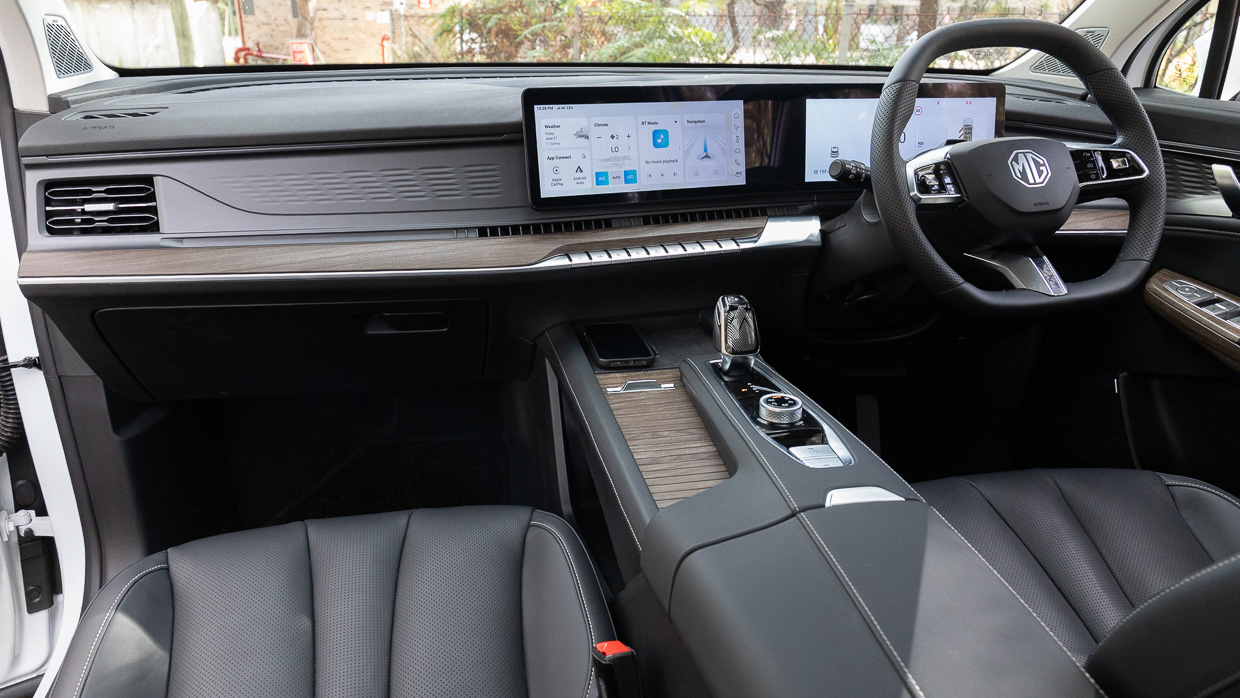
This is where you find the 12-volt socket and two USB-C fast-charge points. They’re on the passenger side, though, and nearly impossible for the driver to reach.
The MG QS offers good versatility, thanks to the 60:40 split second row being on sliders and offering generous backrest adjustment between 21 and 35 degrees of reclination.
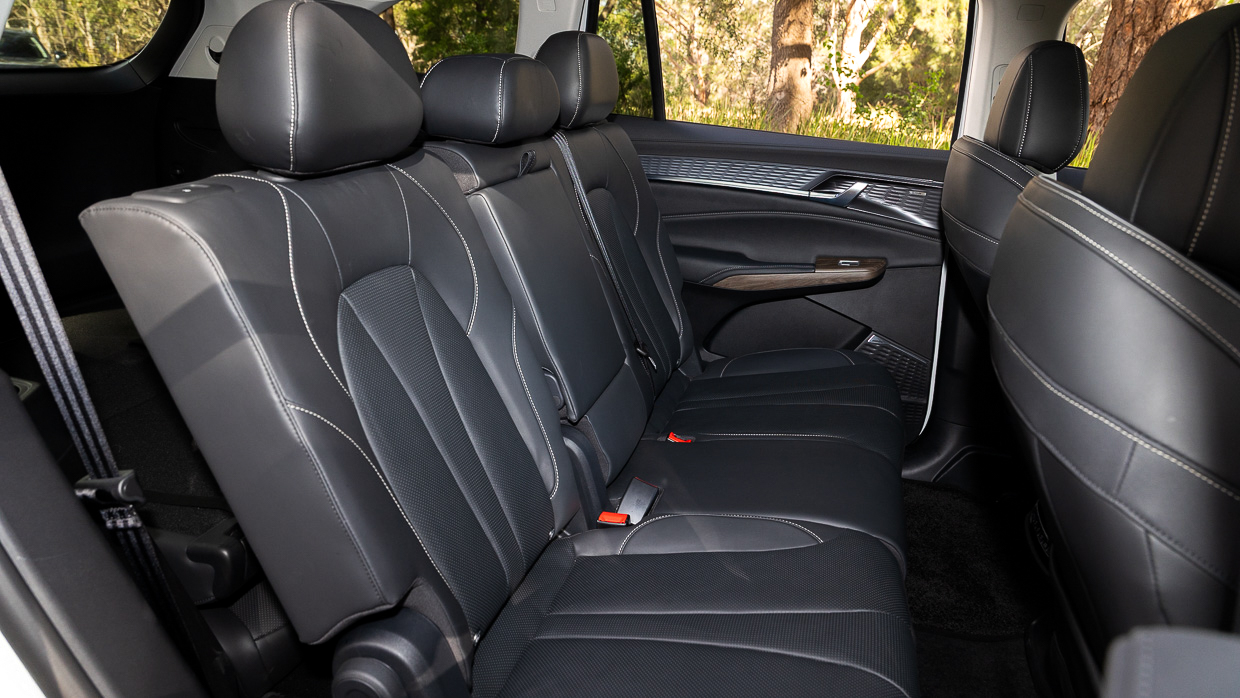
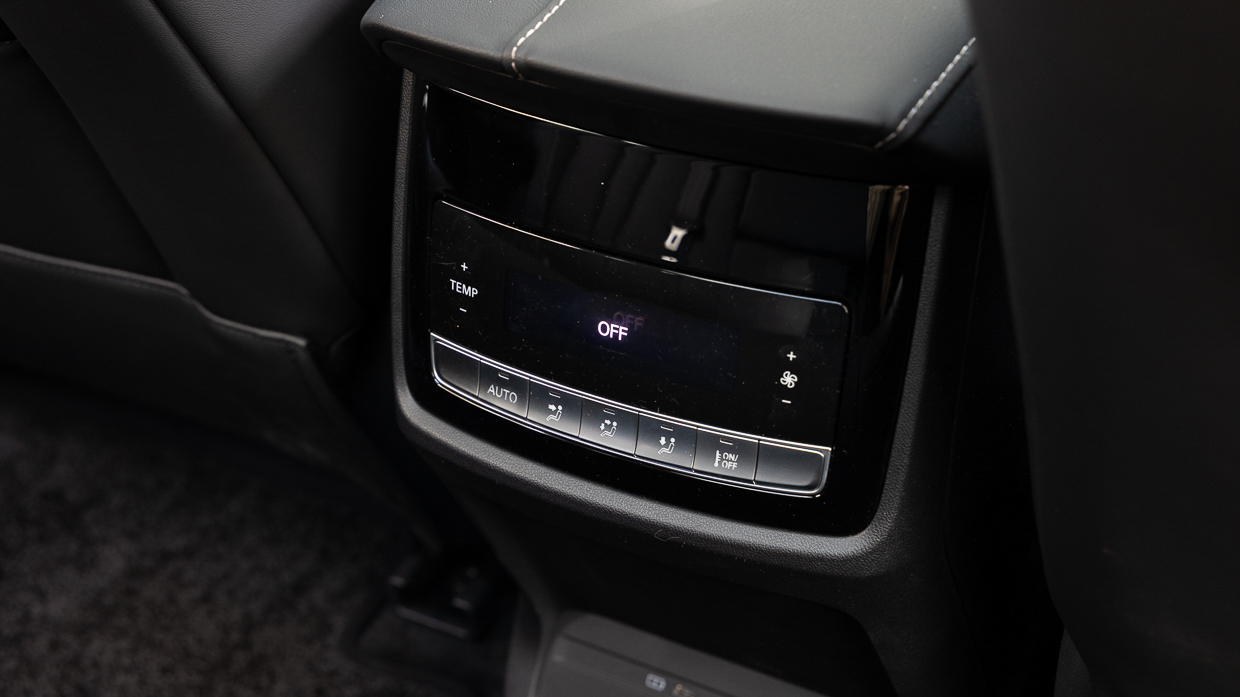
Mid-row passengers have plenty of headroom and loads of light through the standard panoramic sunroof. Flat floor, climate control, no heated seats, USB-C fast charge,
Material quality remains consistent in the second row with squidgy rubber capping on the doors. Door pockets are okay, and there’s a sturdy fold-out armrest in the middle that opens up with two cup holders.
Accessing the back seat is easy … providing no one has parked next to you. The QS’s doors are massive, longer than even a Mazda CX-80. This means getting in and out in even medium-tight carparks can be nearly impossible.

An electronically actuated fold-forward system for third-row access means it is easy for kids to get themselves into the QS’s third row. This is only on the driver’s side, though, so not the Australian kerb-side. The wider, heavier side of the bench has a regular, high-mounted latch.
MG chose not to bring the six-seat option with captain’s chairs that is offered in Chinese-market RX9s, and rivals in Oz, such as the Santa Fe.
The third row is easy to pull up out of the floor and space is respectable back there for adults over short distances. Vision out is better than the second row, and like in the middle there are roof-mounted vents, lights, cup holders, phone storage pockets and even a USB-A charger.
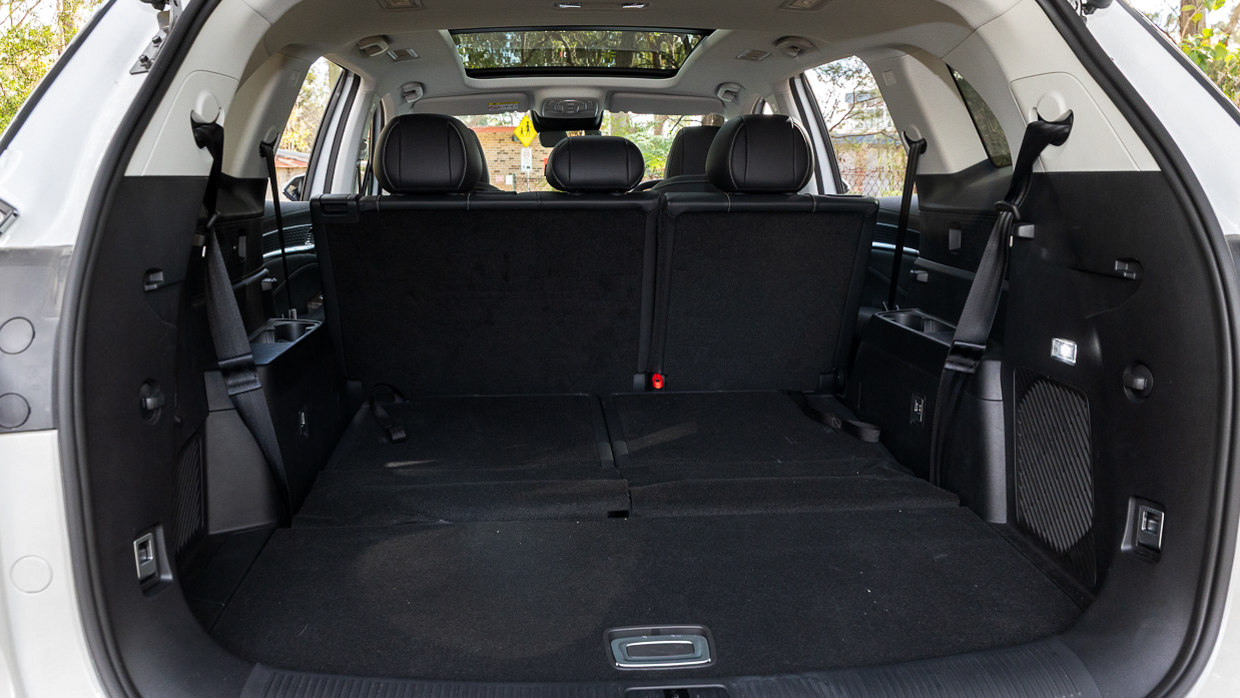
Boot space is impressive, measuring 207 litres with all three rows in place – practically, that’s enough space for backpacks on the school run or a small shop.
Folding the third row increases the space to a generous 517 litres; in van mode with two rows up that climbs to 1052L.
The QS’s wheelarches intrude into the space quite a lot, and the shape of the body means the cargo space isn’t particularly wide. We struggled with a mountain bike that easily fitted into the Hyundai Santa Fe.
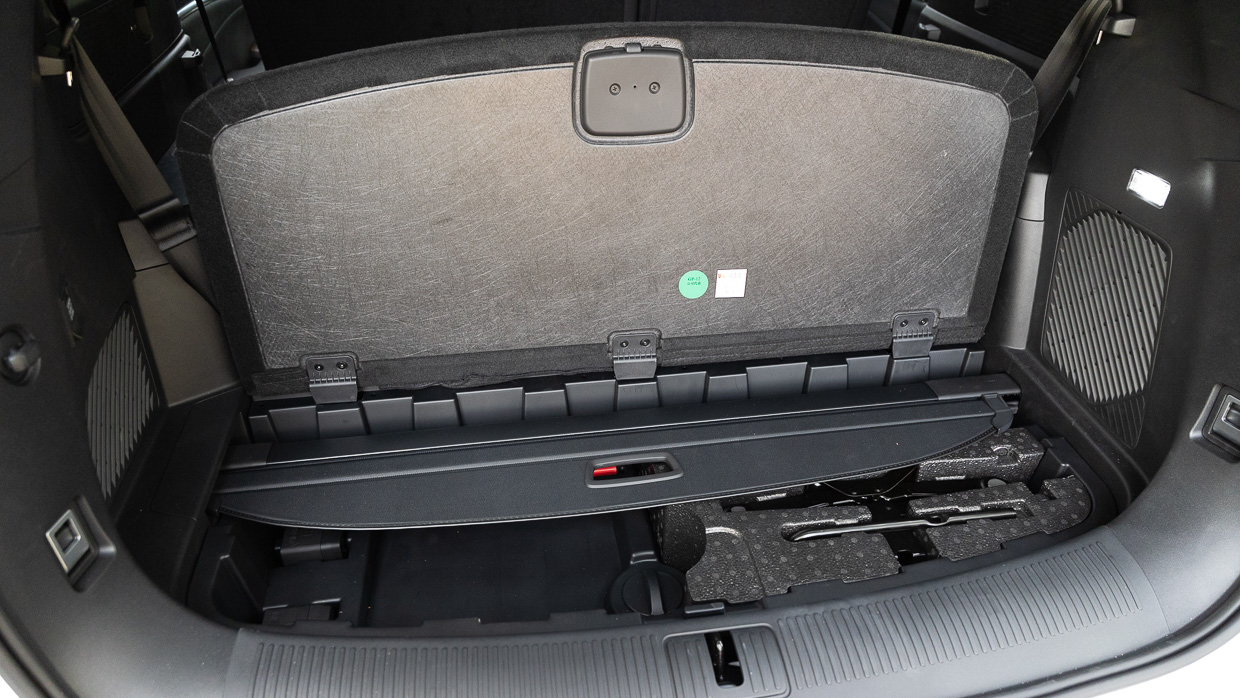
Amenities include a power tailgate, four tie-down points, cargo blind, two shopping bag hooks, and decent lighting. A sub-floor storage area houses the jack and a neat space for the cargo cover when not in use. It also doubles as a wet storage area.
The MG QS features a space-saver spare tyre slung under its rear end.
Is the QS Essence a safe car?
The MG QS has not been awarded a safety rating by ANCAP. Sold in China and the Middle East, ANCAP will have to crash the QS itself as it’s not available in Europe.

It is not short on safety and driver-assistance features, though….
Safety features are listed below
- Seven airbags, including front centre
- Forward auto emergency braking (AEB) with warning
- Lane-keep assist
- Lane-departure warning
- Blind-spot monitoring
- Rear cross-traffic alert with braking
- Adaptive cruise control with stop & go
- Front and rear parking sensors
- Driver-attention monitoring
- Speed limit assist
- Tyre pressure monitoring
The tuning of MG’s systems is improving and our QS test car mostly behaved itself. The speed limit assist was not always accurate and does default to beeping every time the car is turned on, but the sound wasn’t grating – turning it off through the laggy touchscreen is extremely tiring.
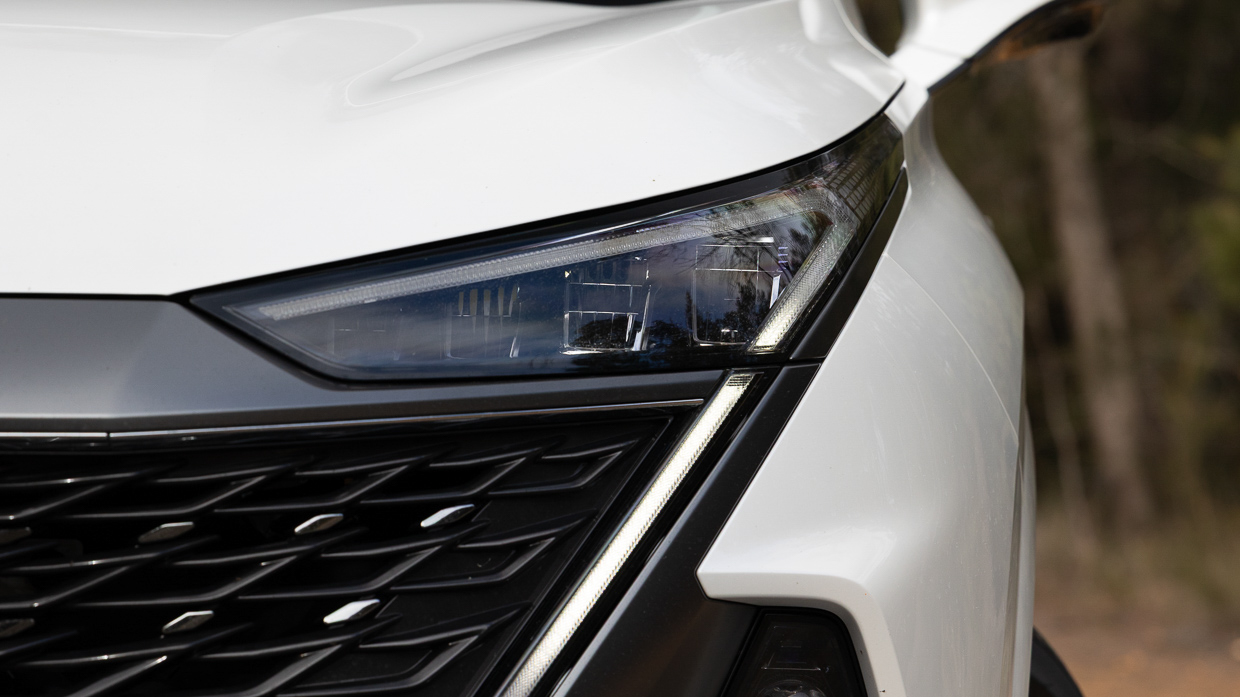
Lane-keep assist behaved itself generally, with only one phantom intrusion. MG needs to revise its adaptive cruise control tuning, which has too great a follow distance for Australian traffic and is inconsistent.
Much of the safety system is quite good, just annoying how you have to turn off using the laggy touchscreen.
More typical systems like the QS’s ABS and ESC – which includes a Sport mode – were mature.
What are the QS Essence’s ownership costs?
MG has recently updated its warranty offering, dropping it from a no-questions-asked 10-year/250,000km warranty.
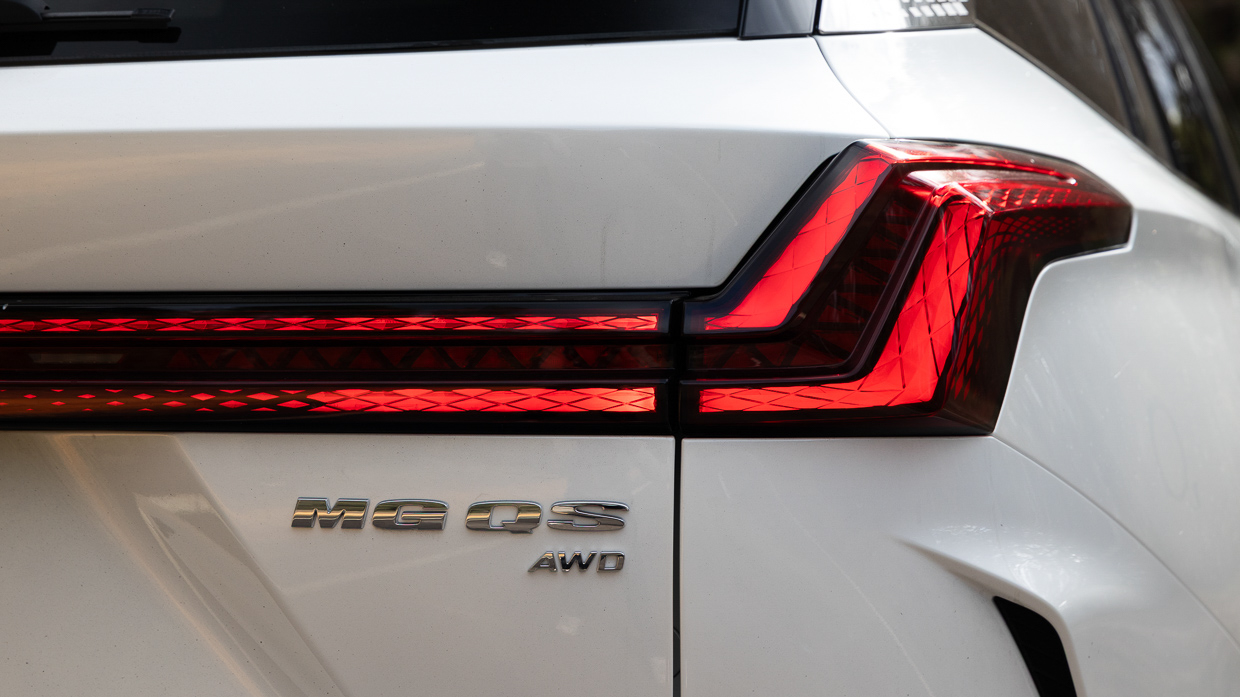
The MG QS is now covered by a seven-year, unlimited kilometre warranty with the option to extend that to 10 years if serviced on time at an MG dealer.
This equals Kia’s warranty, beats Hyundai’s, and is not dissimilar to Mitsubishi’s five-plus-five set-up. Nissan’s 10-year/300,000km warranty.
Servicing the MG QS is quite expensive, however costing $3618 over the first five years for the AWD model. Maintenance is due every 12 months or 15,000km — whichever comes first.
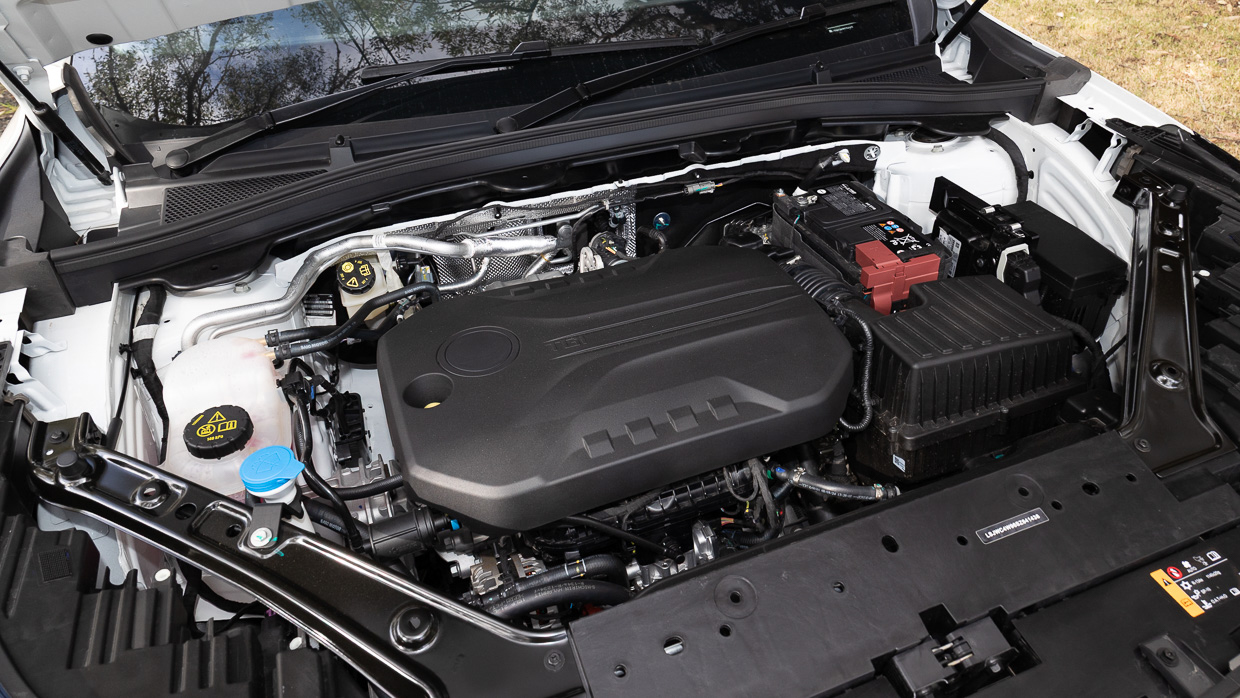
Buyers should be especially cautious looking at a five-year-old QS, though, because at six years/90,000km the MG dealership will sting your $2526 for maintenance on the AWD or wallet-emptying $2920 for the front-wheel drive. We would go quote-hunting at independent mechanics for that service.
Petrol costs will also be elevated in the QS, which requires 95 RON premium unleaded for its 2.0-litre turbo-petrol.
The book figure is 8.8L/100km for the Essence AWD we tested, but real-world driving saw that climb to 10.4L/100km, which was more than the gruntier Hyundai Santa Fe tested on the same route.

We noted the QS was very thirsty around town, regularly exceeding 13L/100km in urban running. MG does not yet offer a hybrid QS, but has not ruled out a future plug-in hybrid (PHEV) variant.
The honest verdict on the QS Essence
There are some glimmers of greatness in the QS. It offers remarkably sophisticated adaptive dampers, polished handling, and – most importantly for families – superb value in the seven-seater-SUV class.
Yet the more we lived with the QS, the more its laggy powertrain and technology drove us to distraction. It’s the sort of car that, strangely, impressed in a back-to-back comparison but was so frustrating to live with.

The QS lacks all-round polish and a sense of cohesion. It feels like a product rushed to market to urgently fill a product gap.
We know MG can do better: give the QS the slicker multimedia system from the S5 electric car, iron out the wrong-drive-side kinks – because the cabin is otherwise genuinely versatile – keep the price competitive, and this three-row SUV could shake up Kluger, Pathfinder, and even Santa Fe.



